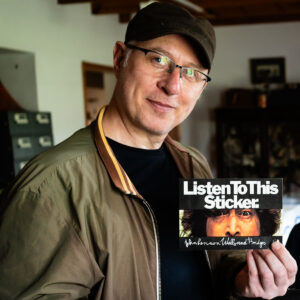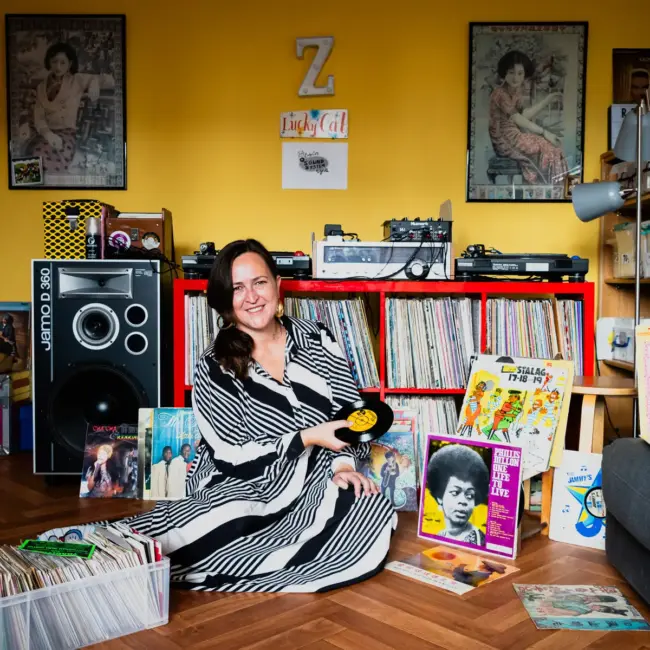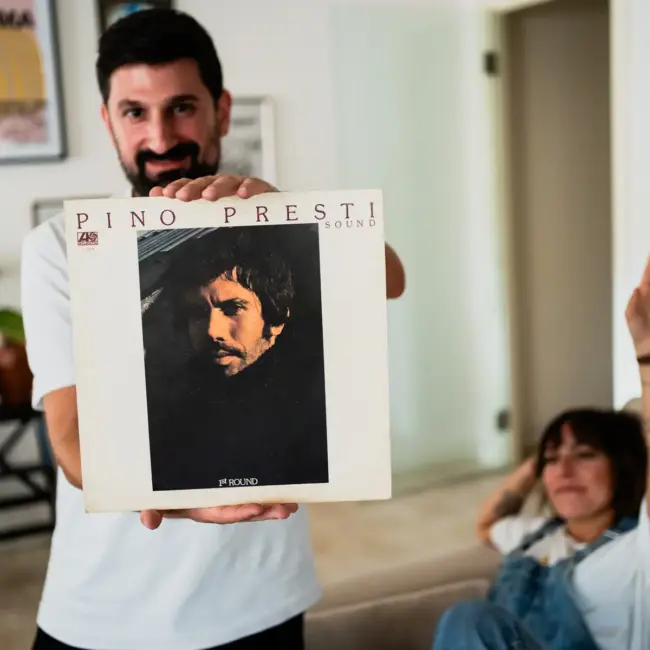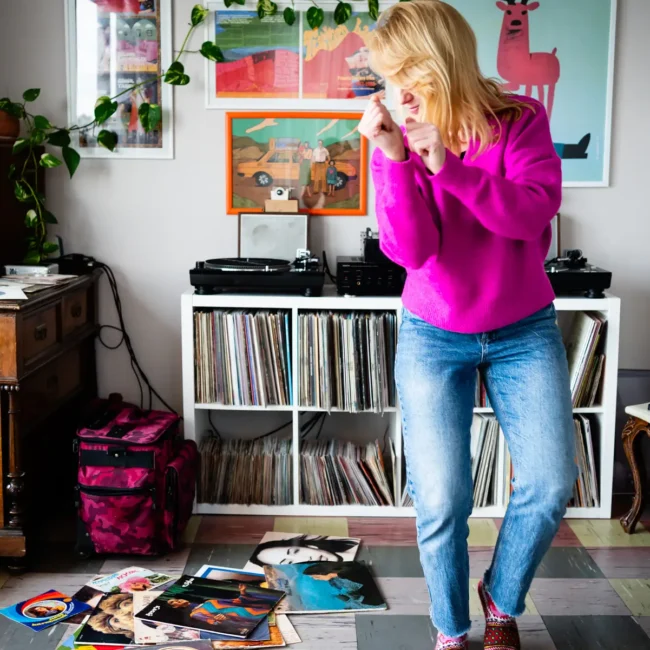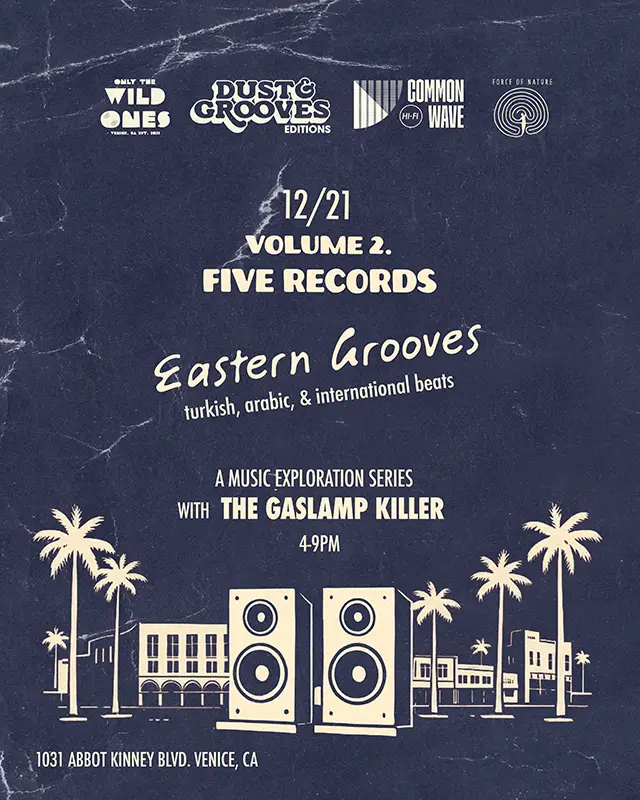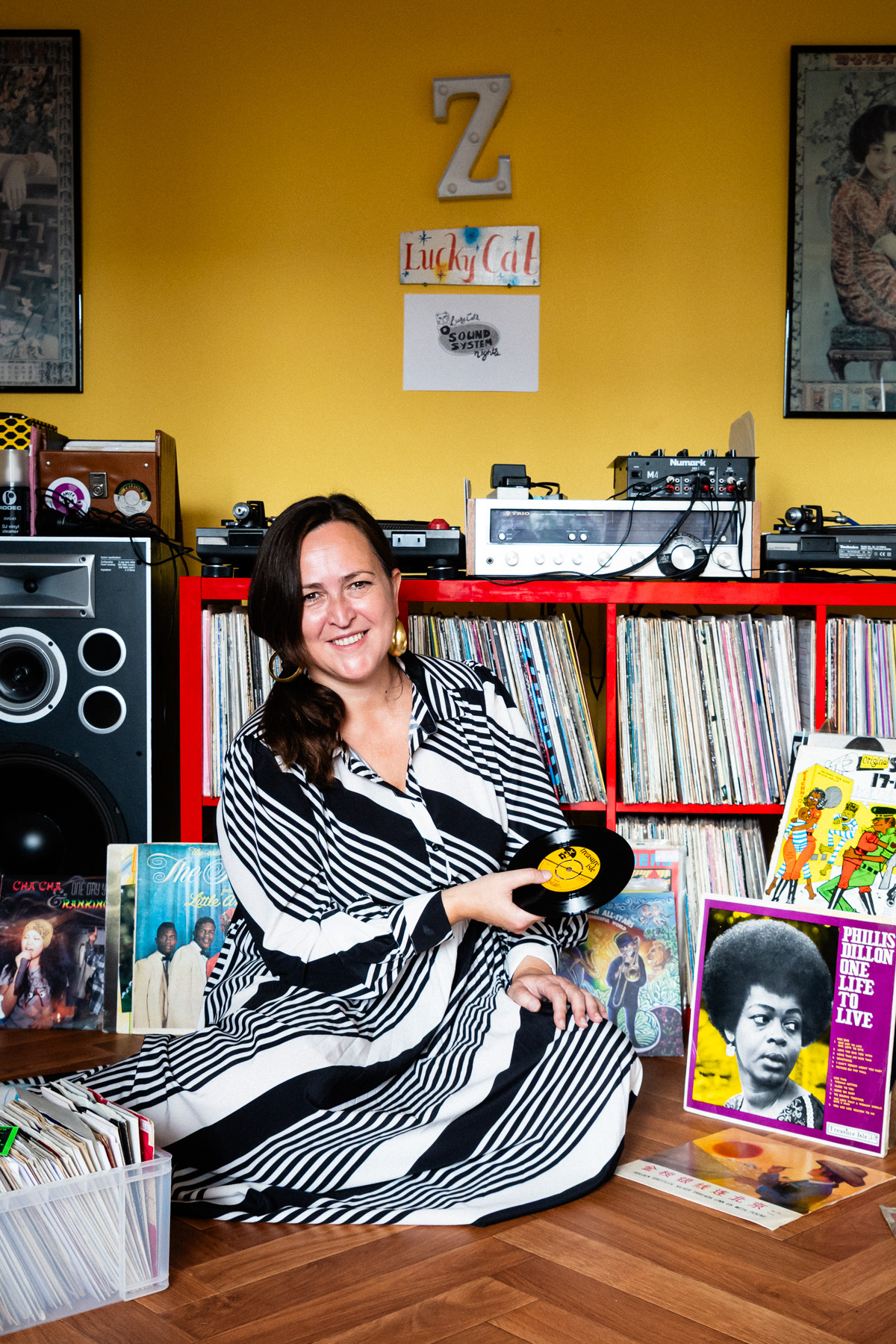
Zoë 'Lucky Cat' Baxter
A Cultural Sound Clash
BY Kevin Foakes
Arriving in Zoë Baxter’s living room is like stepping back in time and entering a contradictory cultural space. Her beloved Jamo speakers stand on either side of the Technics decks, powered by an amp older than she is. There’s a projector but no TV, a huge ‘50s Asian movie poster, and piles of her drawings covering a table in the corner. Trinkets and cartoon toy characters cover surfaces and shelves—Doraemon, the blue cat from Japan, Enid from Daniel Clowes’ Ghost World comic, and various examples of the lucky cats she takes her name from. Boxes of 7-inches, categorized in genres from ska, boss, RnB, rocksteady, 1990s dancehall, French chanteuses, and Chinese and Singaporean are scattered around. A drawing by her dad, the British surrealist artist, Glen Baxter, hangs on the wall; The House of Flying Daggers transformed into The House of Flying Vinyl.
A Londoner who loves reggae and East Asian culture, Zoe has been hosting her Lucky Cat show on the capital’s independent arts radio station, Resonance FM, for over fifteen years. She mixes the sounds and tastes of Jamaica, London, and the Far East into a unique blend each week. The show features the “Dim Sum lunchbox,” where she cooks a different Chinese or East Asian recipe every week and then tries it out on guests in the studio. In recent years, she founded the Sisters of Reggae DJ collective, an all-female crew of DJs. She is currently charting the history of sound system culture via interviews for her Sound System Stories series on the station.
“In the ‘70s it became the custom to put an instrumental ‘version’ on the B side so that MCs could toast over the rhythm after the vocal side was played. Prior to that you might have a ballad on the flip or a great instrumental like this one.”
—Lucky Cat Zoe
Some 45s with the flyer for the Tradition Hi-Fi 35th Anniversary Old Hits Cup Clash held in Nottingham, October 2019. “I was one of eight selectors competing in this clash organized by Tradition Records, my record dealer of choice. It was a wonderful evening and I was very pleased to come in third place. We all played on the Tradition valve sound system, which sounded warm and beautiful. There was some friendly banter and an eclectic atmosphere! Pablo Metro from West London took the cup that night but was given a good fight by Mark the Anthropologist from Norwich. This was my second clash and hopefully not my last.”
What’s really interesting to me is the mix of Chinese culture, Asian culture, and reggae—how did you get to this point? You started buying records when you were about twelve?
My dad collected records, so there were always records around. We were always taught to respect records. My older brother is a saxophonist and pianist, plays music by ear, and was really into music, including reggae, and he’s a bit older than me.
You’re one of five children. Oldest? Youngest?
I’m number four. But there’s quite a gap. My two older sisters and older brother have a different dad. So it’s like fifteen years between me and my oldest sister, and then there’s me and my brother, who came along later, with my dad. A very artsy, creative family: my mum’s an art teacher, and dad was an art teacher. That’s how they met, and then later on, my dad started to do very well with his drawings and became a full-time artist.
It is unusual to have a parent who works at home, and he’s at home all the time. You don’t really realize what’s normal when you’re growing up. You think, “This is normal,” and then you go round to someone else’s house and think, “Hold on a minute…” They used to be beatniks, but that was back in the day.
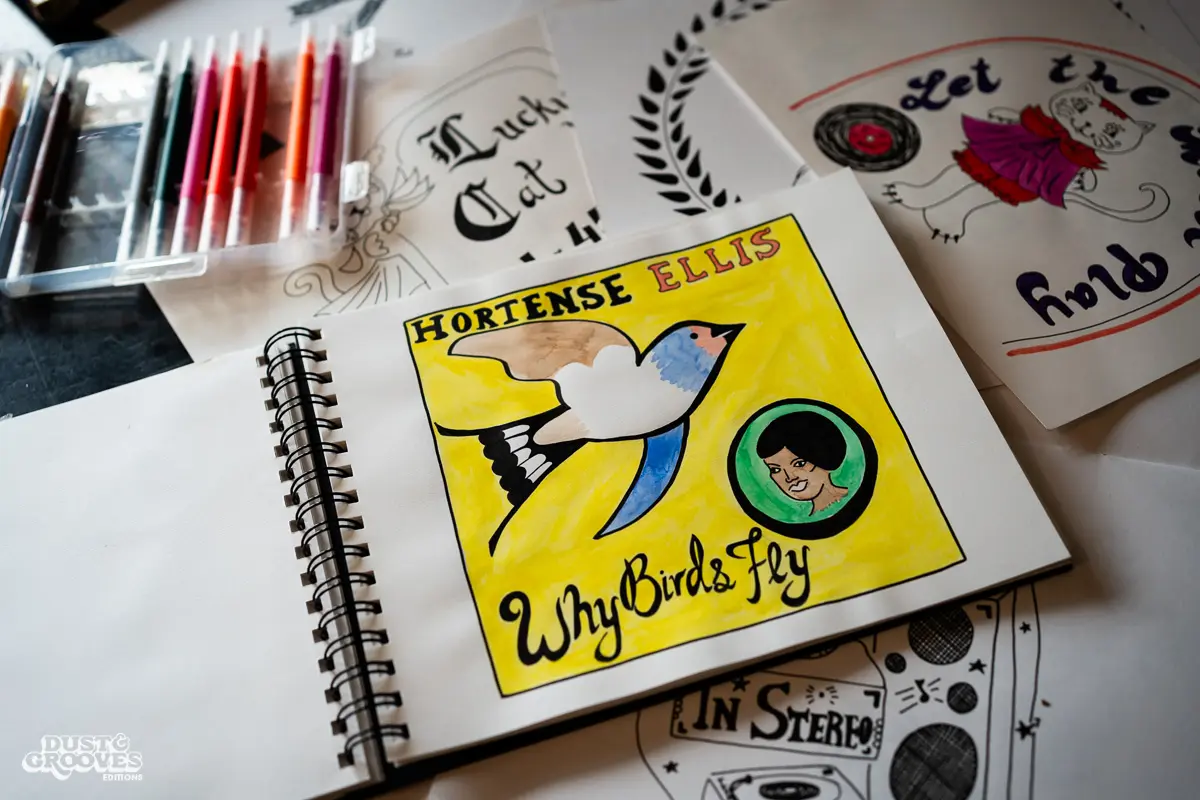
Some of Zoe’s artworks on display. “The cat in the background is the same cat from the Mimi and the Five Petals 45 pictured elsewhere. In the forefront, you can see a watercolor of an imaginary record sleeve.”
What music was your dad into?
My dad and his best friend Charlie often talked about music. His best friends, Dizzy and Charlie, moved to Athens, and we’d go out and visit them every summer. Charlie was a massive blues collector who ended up selling many of his records; however, he was also a collector of Rebetiko (Greek folk music), a beautiful genre with many great female stars.
Rosa Eskenazi was a Jewish singer who pretended not to be Jewish so that she could smuggle lots of people out in the 1940s in Greece, which was, of course, invaded by the Germans. So, they’re the sort of records where people cough in them and stuff, because they’re all in a hashish den, playing their Bazukis and talking in the intro or something. It gives a nice, natural authenticity to it.
When you went on holiday to Greece, were your dad and his friends looking for records?
No, they were just playing records and talking incessantly about music, football, and cinema while cracking dirty jokes. Records were always of high esteem, and my dad told a story I’ll never forget about his friend. Dad met up with many New York City poets in the 1970s, such as Ron Padgett and Larry Fagin. He told us a story about Larry’s girlfriend who was a junkie and used the story as a warning about what drugs can do to you but then also how important records are. Larry had gone out of town for the weekend, and she sold his entire record collection, which he had to go around everywhere and buy back. It has always impressed us that this is probably the worst thing you could do to another human being.
When I was twelve, at the school jumble sale, I bought a portable record player, and I bought this [brings out a red record tote box], which I will show you because I still keep it. I bought some records that day, like Pinocchio, and then I started filling it with records. I also found a swatch watch at a jumble sale. I loved Swatch watches and their bold graphic designs. The epitome of ‘80s cool!
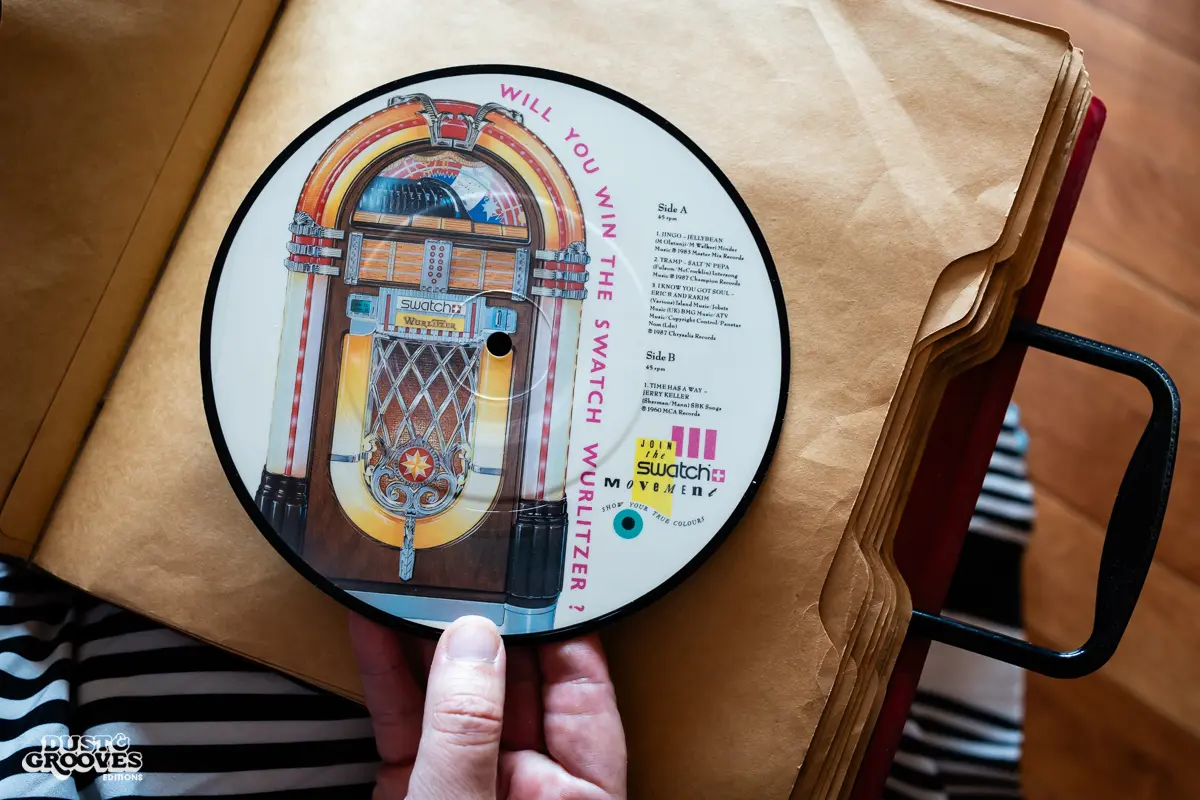
Various Artists – Swatch Megamix. A promotional record issued by Swatch watches featuring Jellybean, Salt ‘n’ Pepa, Eric B & Rakim, and 1950s crooner Jerry Keller on the flip with “Time Has A Way” (originally on the B side of “Here Comes Summer”). “This was a jumble sale buy; I loved Swatch watches and their bold graphic designs. The epitome of ‘80s cool! There was a competition to win a Wurlitzer jukebox on the record; the ‘80s were full of 1950s nostalgia, which I adored.”
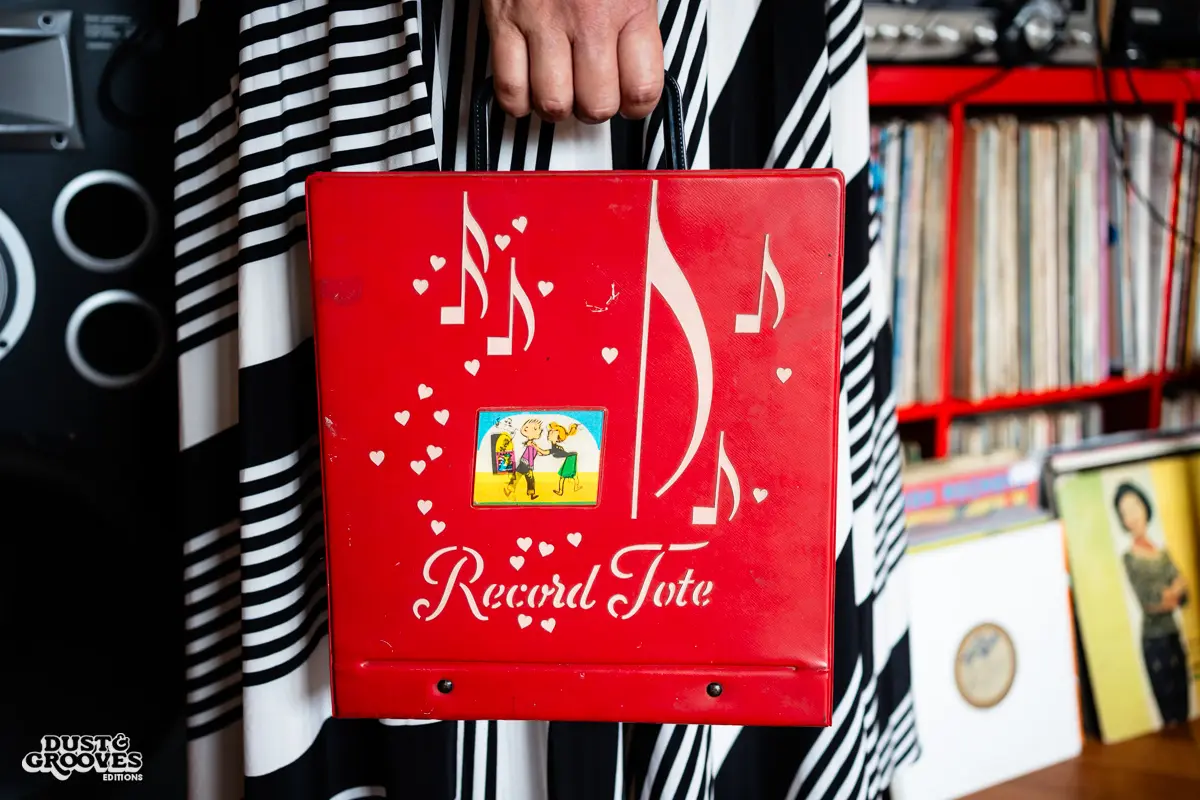
“My lovely record tote case was purchased at the school jumble sale, at the same time I bought my first turntable, about age 11. It is big enough to hold 7-inches or 10-inches. When you move it around, the little dancers move too. It smells great too!”
Was that music from your dad?
To continue reading this interview we humbly ask you to consider supporting Dust & Grooves by becoming a paying premium member.
It wasn’t, I never felt like I was born in the right era.
Which is why Ghost World appeals to you?
Yeah, basically, when my friends watched it, they were like, “Oh, this is you.”
So, you were into music, as most teenagers are, at twelve years old?
Yeah, but not really pop music. I liked rock and roll and RnB.
Where were you hearing that?
Well, I loved the cinema of the 1940s and 1950s.
And where were you seeing that?
My parents and all the Busby Berkeley musicals. My favorite one was The Gang’s All Here, with Benny Goodman. My friend and I used to dance around her front room to her dad’s Ella Fitzgerald records. We loved all of that. I just didn’t really want to live in the present. There were some concessions to what was happening, but I didn’t want to be a societal outcast.
I liked Madonna because she did a homage to the Marilyn Monroe film Diamonds Are A Girl’s Best Friend, which I could relate to. I liked her kind of feistiness, and Desperately Seeking Susan was good. When she came on TV, dad said, “Who’s that strumpet?” So I thought, “Okay, they don’t like her, great, so this is something to do.” My dad is a massive Hank Williams fan, and I always hated country. Now, I love country, and I’ve got Hank Williams records. So I’ve come full circle with that.
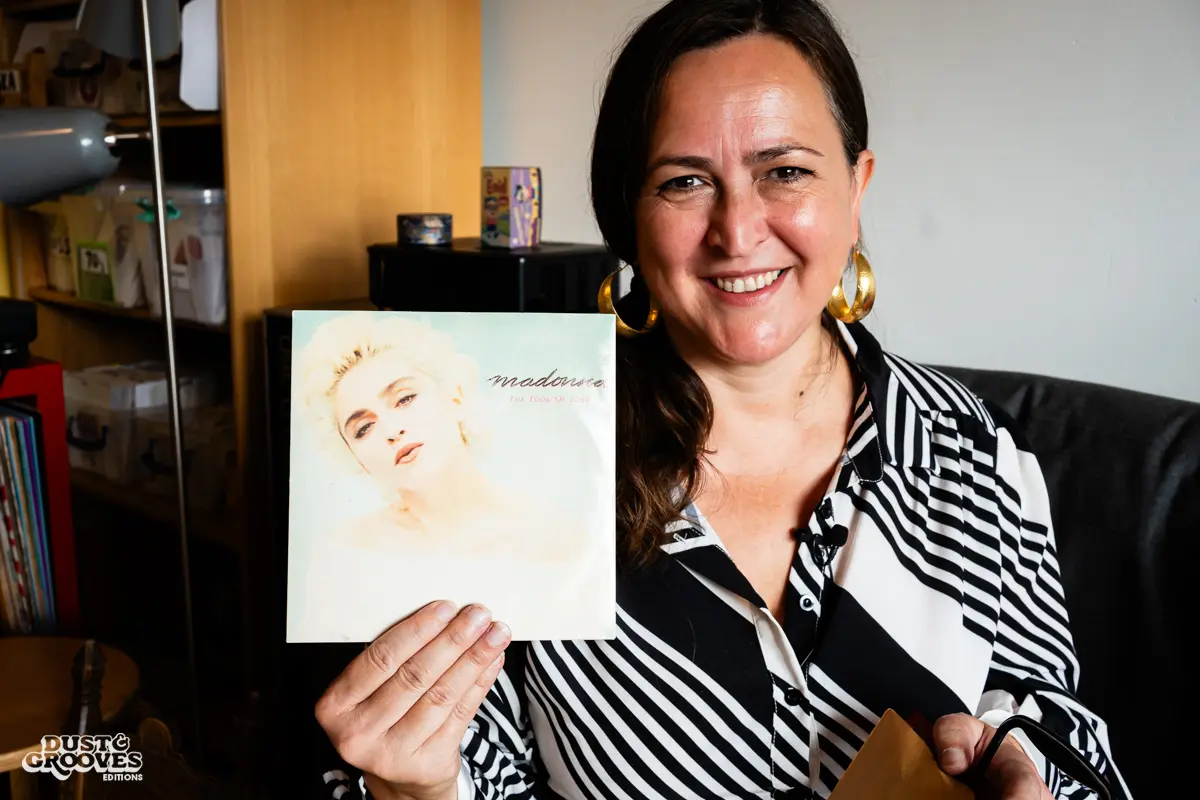
Madonna – “The Look of Love.” A ballad track from the soundtrack of Who’s That Girl. “In school, I was eager to purchase some new music. I went to my local Woolworths and could only find this 45 to buy, very uncool, but here it is. I was a Madonna fan who adored Desperately Seeking Susan and had the Like a Virgin album on cassette. I’m slightly embarrassed about this one, but I have kept it all these years.”
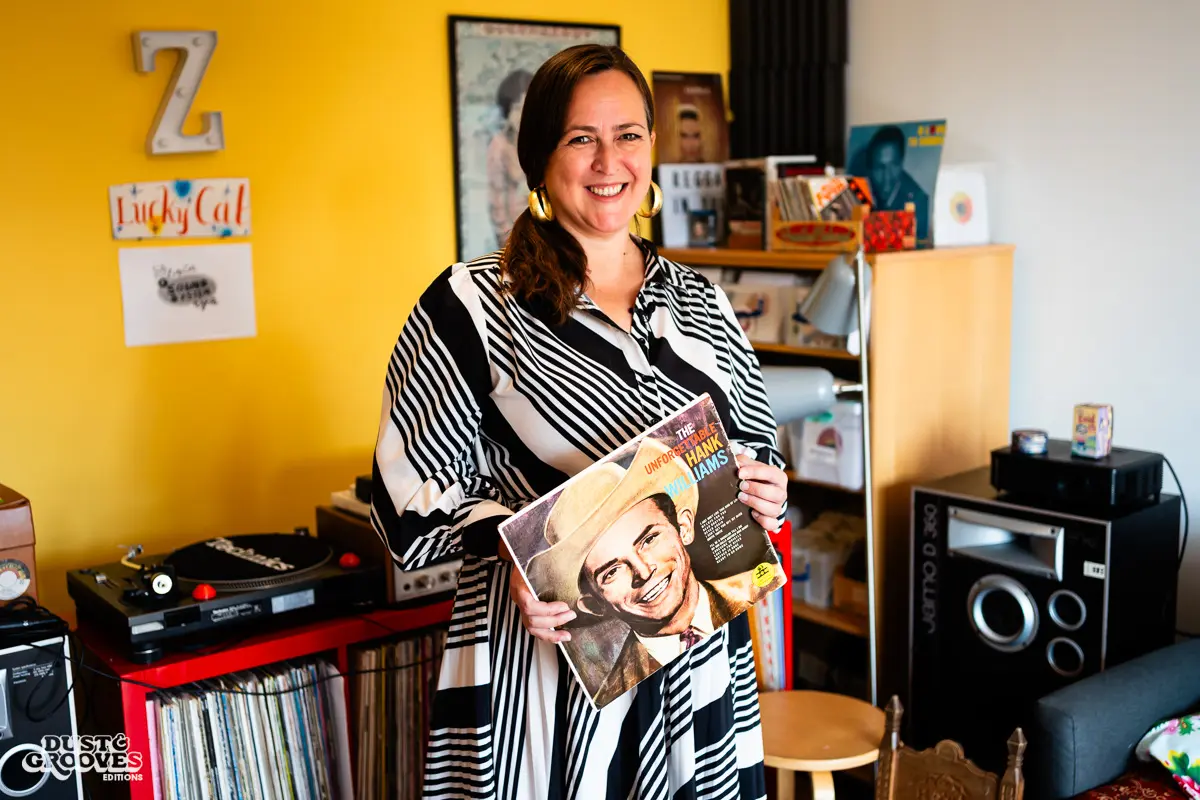
Hank Williams – The Unforgettable Hank Williams. “My dad is a massive Hank Williams fan, and I always hated country growing up. I thought it was corny and laughable. As I grew older, I began to understand and appreciate the genius of Hank Williams’ songwriting and the sincerity of the emotion.
“In my late twenties, I was introduced to ‘the list’ … Once a month, you'd get a paper list in the post of records, and then you'd have to quickly phone Andrew (Neale) to tell him which ones you wanted, and then pay for them.”
This is another string to your bow that I had no idea about, the country angle. Or was it just Hank Williams?
Also, Patsy Cline; it’s mainly Hank and Patsy.
Have you got a definitive Patsy Cline record? Is there a particular tune?
There’s a record called “She’s Got You,” and one of the things in the lyrics is, “I’ve got your records, but she’s got you.” I listened, thinking, “Okay, I got the records.” There was a movie about her life with Jessica Lange called Sweet Dreams that we used to watch. My friends and I all liked that when we were growing up.
In the 1980s, there was a bit of a 1950s revival, and you had films like Dirty Dancing, which had “Love Is Strange” on the soundtrack. I wasn’t a fan of the film, but I thought the soundtrack was amazing. So then I researched and looked at all the tracks.
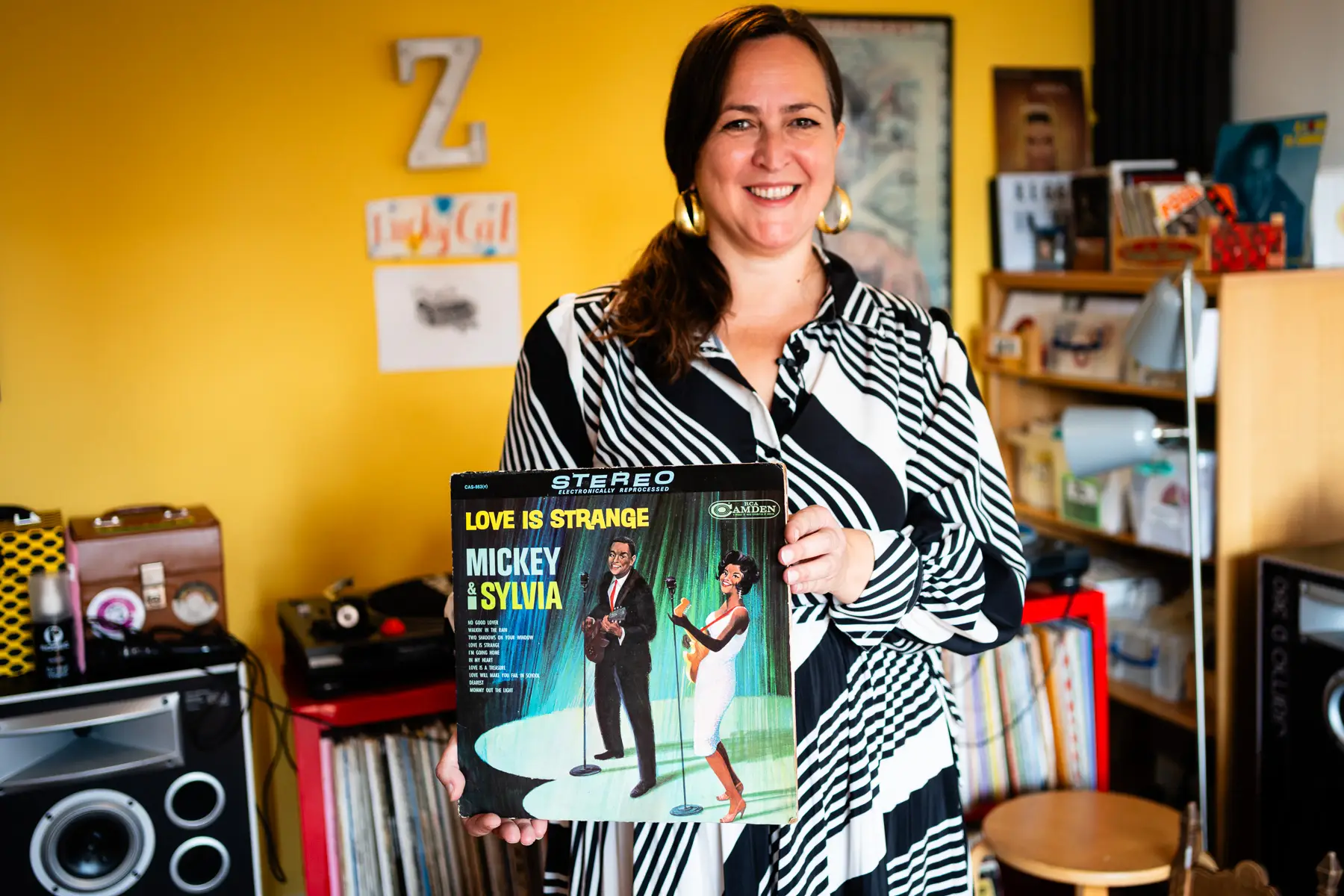
Mickey and Sylvia – Love Is Strange. Mickey Baker and Sylvia Robinson split in the ‘60s, and in the ‘70s, Sylvia went on to perform as a solo singer and was one of the founders of the rap label Sugar Hill Records. “I researched all the tracks and I found out that Mickey and Sylvia were really popular in Jamaica. Joya Landis recorded a cover of their track ‘Mommy Out De Light’ for producer Duke Reid in 1968.”
So, you’re buying records, getting into music, and you feel like you’re out of time. When did reggae come in? Which comes first: The Asian interest or reggae?
Reggae, the Asian interest is with my parents, who went to the same Chinese restaurant in Chinatown for 30 years, they had some Chinese friends they used to go with.
And you used to go with them?
Yeah, always a big love for Chinese food. Later on, maybe into my late teens, I got into Chinese cinema and stuff, especially martial arts cinema. But reggae came first because, growing up in South London, reggae was everywhere.
Where did you grow up exactly?
Walworth Road, Camberwell. So I remember being in the garden and hearing the neighbor blasting out “Buffalo Soldier” and then hearing more of the other UK artists, like this song, “Cockney Translator” (by Smiley Culture), and Desmond Dekker. I wasn’t really interested in pop music, so I thought, “What am I interested in?” It was the Jamaican music of the late 1980s and early 1990s.
So it’s more digital?
Yeah, digital. That’s why I’ve got quite a lot of 1990s dancehall.
Reggae records are known for their wonderful covers. Do you have any favorites?
I absolutely love the cover of Sizzla’s Praise Ye Jah. It is so playful, and Sizzla is wearing Clarks shoes, a Jamaican favorite! I bought this in New York when I went to a flea market in Chelsea. I love Wilfred Limonious and his cover art on Original Stalag. One that my dad handed down to me is We Are The Imperials, and I just love this cover.
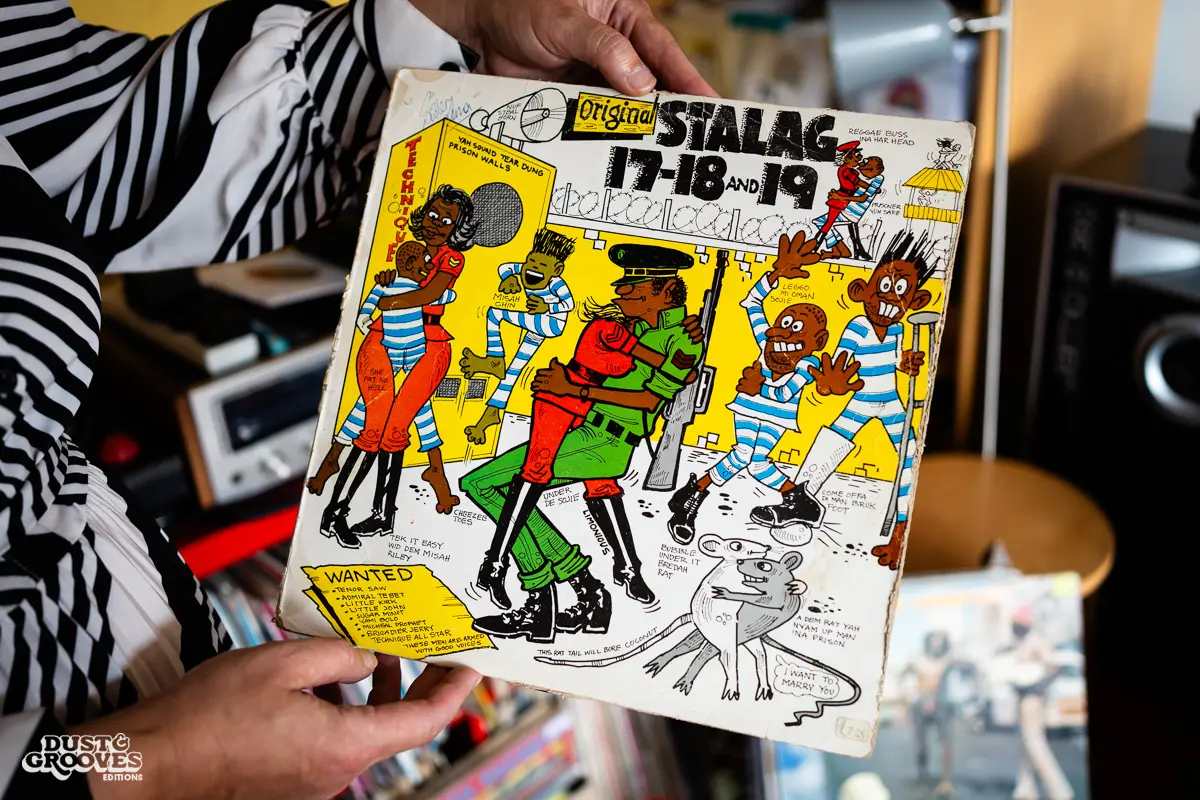
Various Artists – Original Stalag 17-18 and 19. The Stalag rhythm was created by producer Winston Riley, who tragically met a sticky end, shot dead in 2012 at just 68. Riley started as a singer in the group The Techniques and later became a prolific producer, naming his label Techniques. “Stalag is my favorite rhythm, I love it so much! This is a wonderful LP for the music and also for the incredible artwork by Wilfred Limonious. Along with all the hits by Sister Nancy and Tenor Saw on the record, I love Yami Bolo’s ‘When A Man’s in Love.’ You just have to bend and sway when you hear the bass and drums drop.”
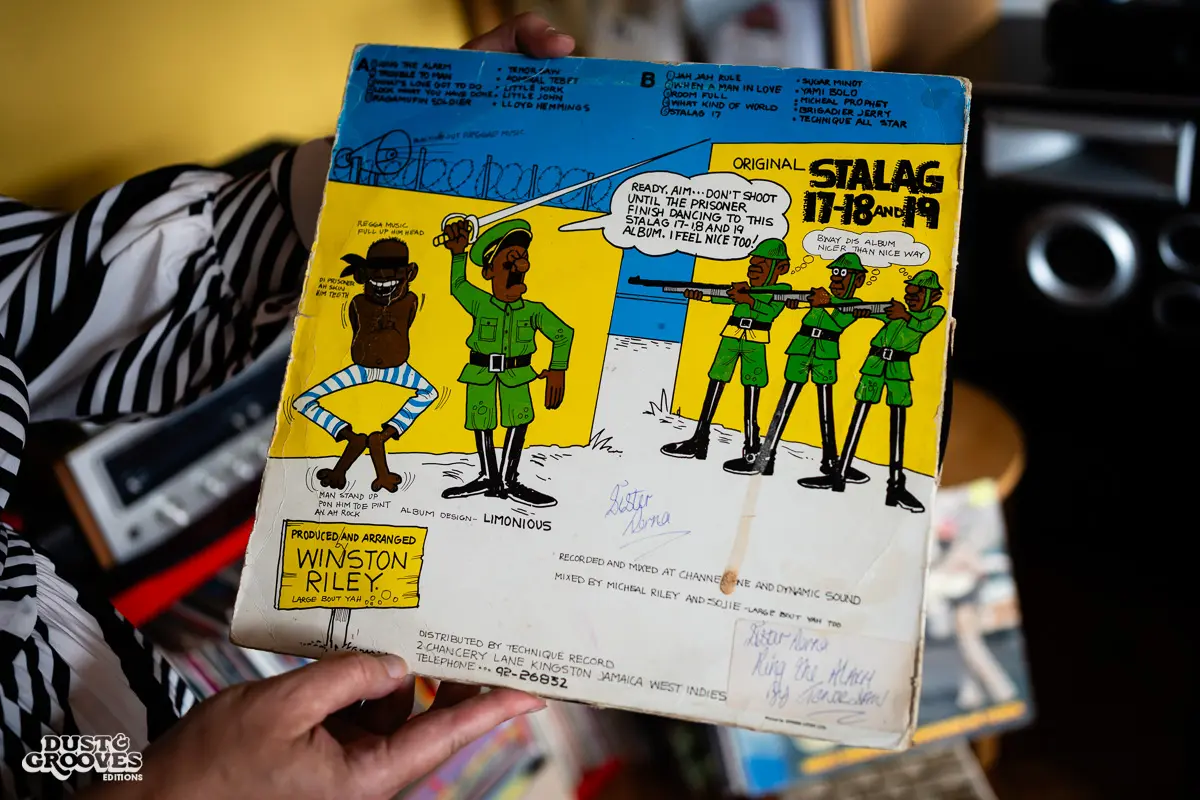
Back of Original Stalag 17-18 and 19. A few years back, Al Fingers and Christopher Bateman put out a great book, In Fine Style: The Dancehall Art of Wilfred Limonious.“There was an accompanying exhibition that I went to see in Oldham. The humor and movement Limonius captures in his illustrations is truly inspiring.”
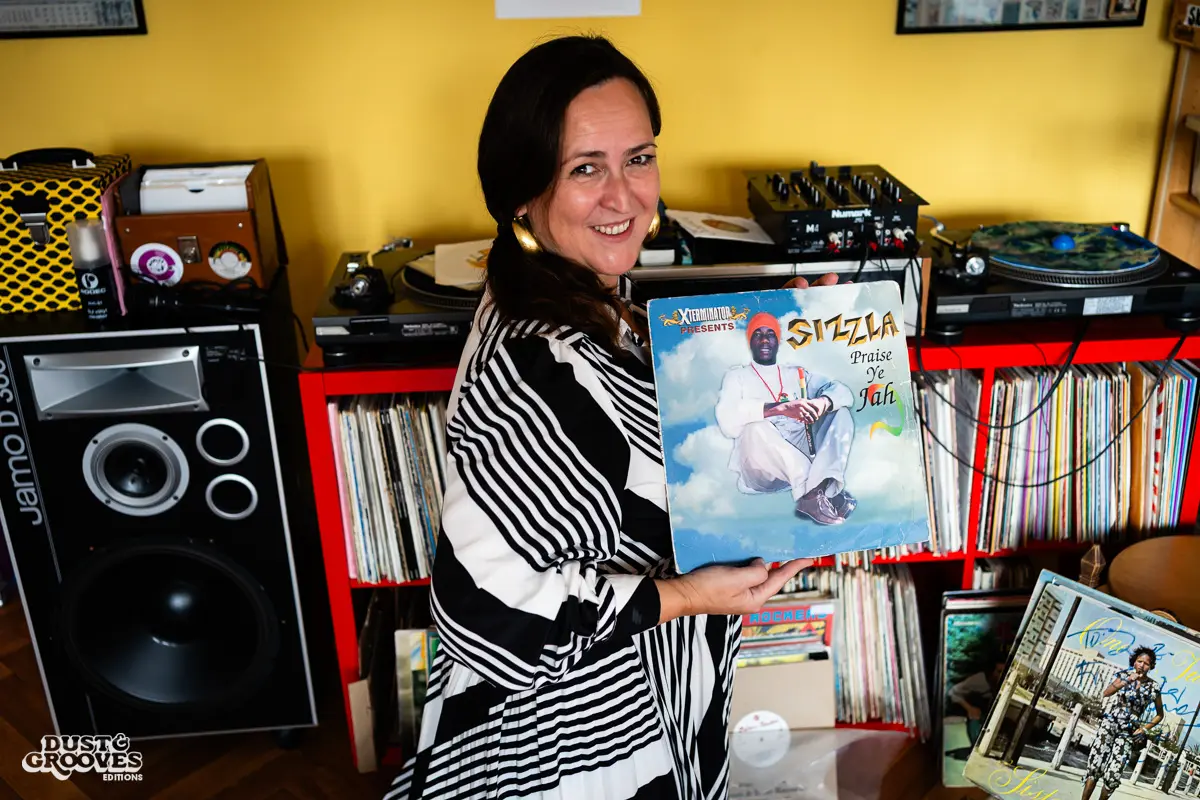
Sizzla – Praise Ye Jah. Sizzla Kaungi aka Miguel Collins is a singjay – this means he both sings and DJs. Sizzla gained popularity in the ‘90s with his raspy delivery, roots and culture Rasta lyrics, and bombastic energy. “I absolutely love this cover. It is so playful, and Sizzla is wearing Clarks shoes, a Jamaican favorite! I bought this in New York, when I went to a flea market in Chelsea. I had this stack of records like, ‘I’m never gonna afford all of these.’ And then suddenly the guy goes, ‘Sale today! Everything’s $1.’ That was a good day.”
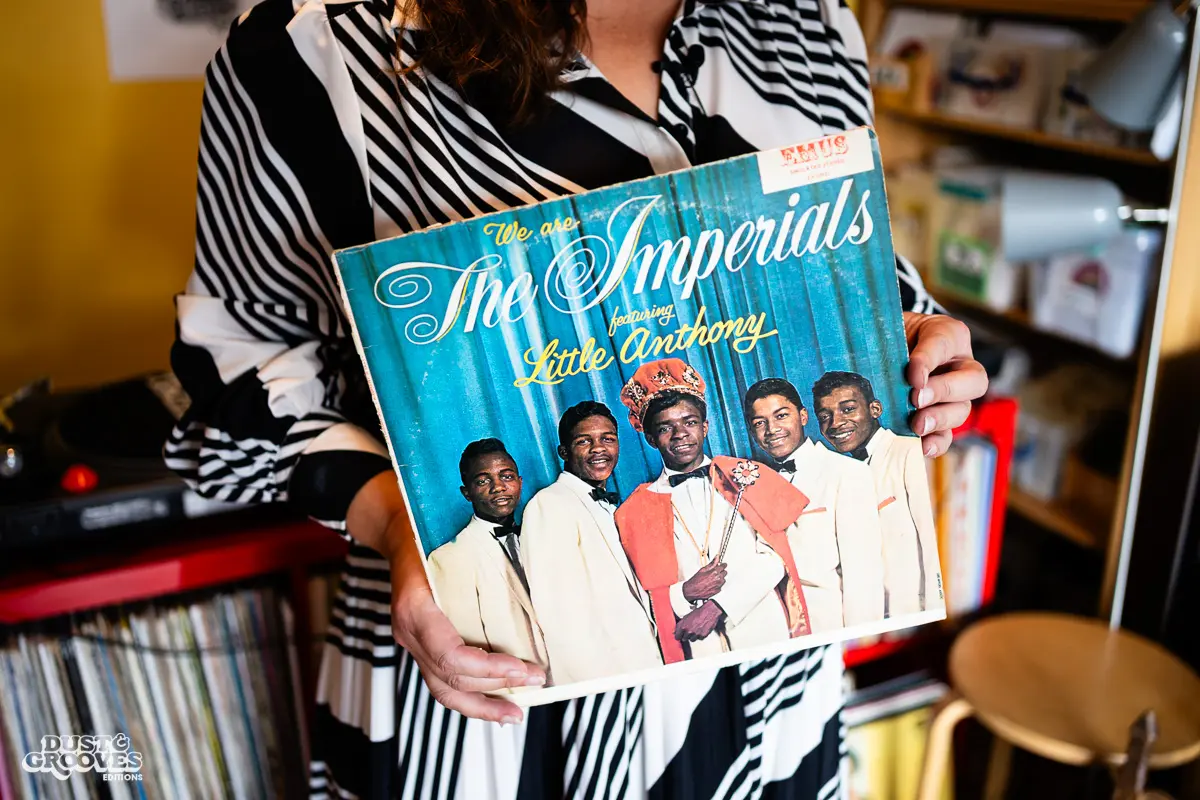
Anthony and the Imperials – We Are The Imperials Featuring Little Anthony. “I just love this cover. This is one of my Dad’s that he handed down to me. I love the sentimental and passionate thrill of doo wop music, ‘Tears On My Pillow’ is the most classic on this record. I grew up listening to a lot of doo wop, my parents love Frankie Lymon, Harvey & the Moon Glows, all those wonderful groups which Scorsese has featured heavily in his movie soundtracks over the years. I was raised on The Ink Spots!”
What was the first reggae record you owned? The first that you sought out and thought, “I like this.”
Buju Banton’s Mr. Mention is my first and favorite. This is on Penthouse Records, a label founded by Donovan Jermaine. He’s still going. It’s a great label, and then I discovered that reggae wasn’t really about albums. It was more about singles because artists would work with so many different producers. So I started buying compilations. But there were very few albums like this; it’s an example of an artist and their work.
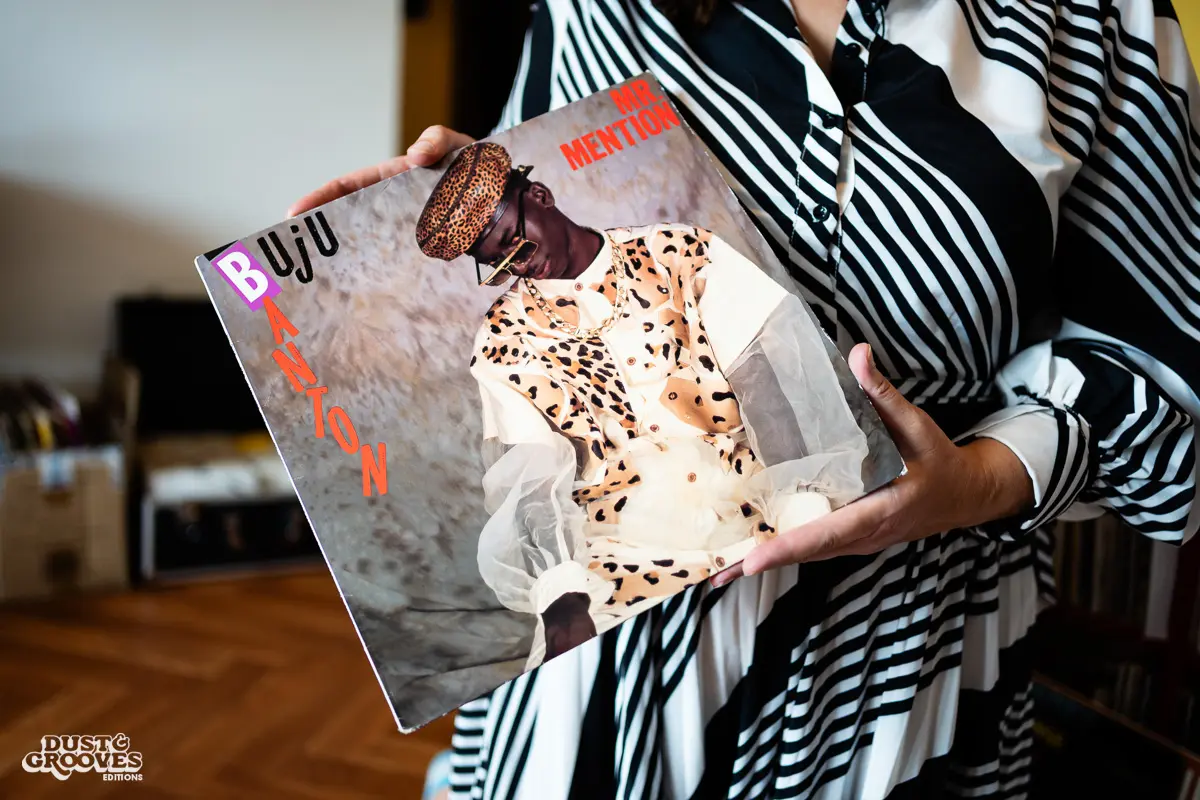
Buju Banton – Mr Mention. “This was the first Buju Banton record I bought. The energy and exuberance of Buju Banton had me hooked the first time I heard him on the mic. This was before he found Rastafarianism; this is pure dancehall produced by one of the greats, Donovan Germain. We didn’t call it dancehall then, though, we called it ragga (short for raggamuffin). I just love the outfit too, chiffon and leopard skin, so understated!”
He got in trouble, didn’t he?
He made a controversial homophobic record called Boom Bye Bye. He was nineteen when he made that record in the atmosphere of Jamaica, which was incredibly religious. He has since apologized, and I think it’s okay now, but he can’t come to the UK because he was convicted of a drug charge, and he was in prison for it.
Buju served time in prison in America on drugs and firearm charges. He was released the year before lockdown began. Everyone was so excited about him getting out, but I didn’t buy his latest album. Til Shiloh is the best one because this is when Buju found Rastafarianism, and his music became a lot more within the roots tradition of reggae and wasn’t so much dancehall.
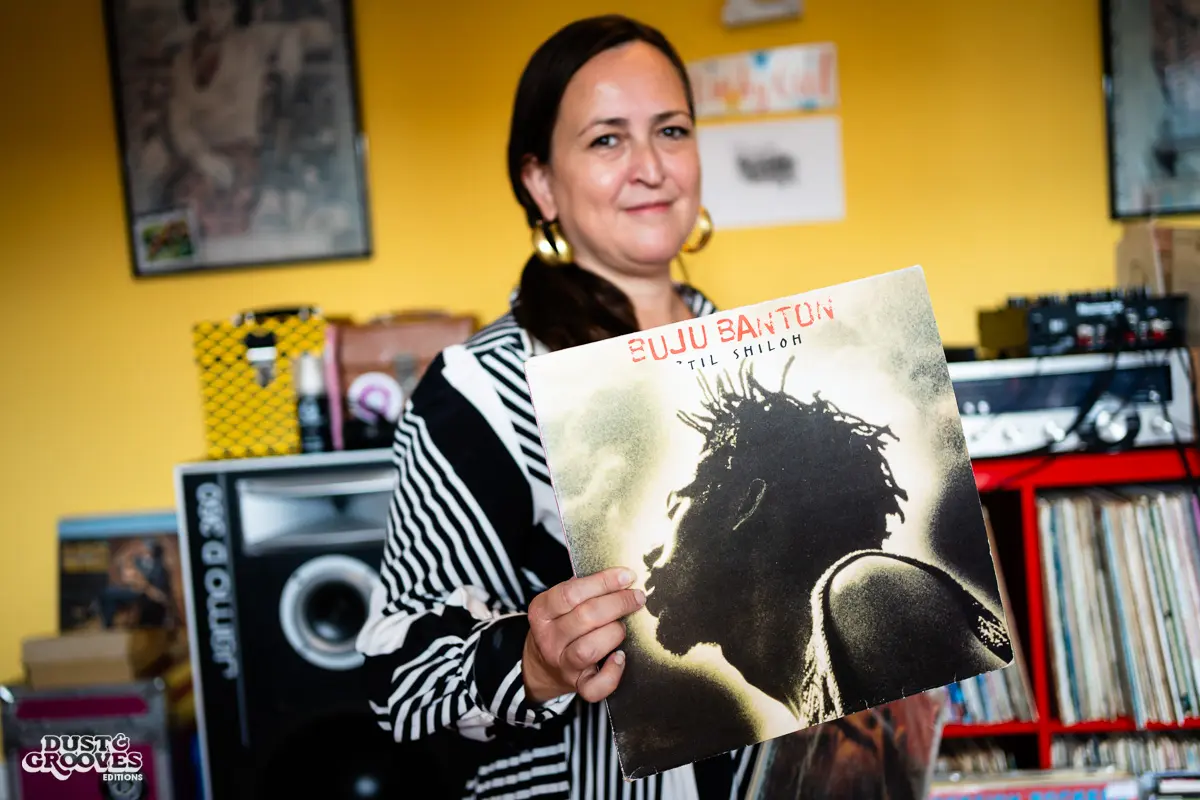
Buju Banton – ‘Til Shiloh. Released in 1995, this album marked a new creative and spiritual awakening for Buju Banton. Til Shiloh means until forever or until the judgment. It was a big lyrical and musical departure from Buju’s previous work. “I remember when this came out and the excitement and intrigue surrounding it. This LP shows Buju’s new depth and maturity, which honors the tradition of Rastafari teachings in reggae music. I’ve seen him twice perform live in the UK; his energy and charisma are unmatched for me.”
Do you care for the analog/digital side of things with reggae? Some real purists don’t touch digital at all, right?
No, because this is my youth, and this is nostalgic for me; it doesn’t matter. I love to hear instruments, and I think digital has done a lot of damage to the industry, but I’m not dismissive of it and I embrace it. Now you listen back, there’s a lot of great music. With collecting, people were snobbish about dancehall for a while, saying, “Oh, it’s worth nothing,” but I’ve noticed the prices are going up. So I noticed that being valued more.
When you found that, were you just completely smitten?
Yes, and I still had all my other influences as well. My dad plays boogie woogie piano, and he used to listen to a lot of blues as well, and then I went to see a movie about the Brill Building in New York, about Leiber and Stoller and all these amazing songwriters. I’ve got this album here, The Dimension Dolls by The Cookies; Carole King wrote for these guys, and the Brill Building was like a factory for songwriters.
Bobby Darin worked there, and I love all the girl groups and that sound. I also love doo-wop, as my dad was a big doo-wop fan. I was living in two places; I was living in the 1990s dancehall, but living in 1950s Americana as well. I also bought jungle; I love the bass and the energy of jungle, and it felt like it was our music.
Further Adventures in Record Collecting
Dust & Grooves Vol. 2
Zoë and 150 other great collectors are featured in the book Dust & Grooves Vol 2: Further Adventures in Record Collecting.
“When I bought a record, I would record it on tape, place it in the sleeve, and I would never play it again; that was it. Tapes were my thing, so I had a Walkman; this was how I would operate.”
When did you decide to be a DJ? Did you want to be a radio presenter? Or were you into clubbing?
I was quite shy, so it didn’t happen until a lot later. I used to make my friend mix cassettes and pretend I was a DJ and do some silly voices and skits, they don’t exist anymore, thankfully. The first time I DJ’d, I was 25, and my sister asked me to DJ at her 40th birthday party.
Did you have turntables, or did you just have a record collection?
My younger brother is a massive hip-hop nerd, so he had decks. I had the stack system with the bright turquoise equalizer buttons and the high-speed dubbing, double tapes. What I would do, because I had this story from my dad about how records are important, was never leave them out of the sleeves—never, never, never, never. When I bought a record, I would record it on tape, place it in the sleeve, and I would never play it again; that was it. Tapes were my thing, so I had a Walkman; this was how I would operate.
Do you collect dubplates?
I haven’t had any dubplates cut for myself yet, but I’ve thought about it. You can only play dubplate acetates a certain amount of times, and who knows how many spins they have already taken?
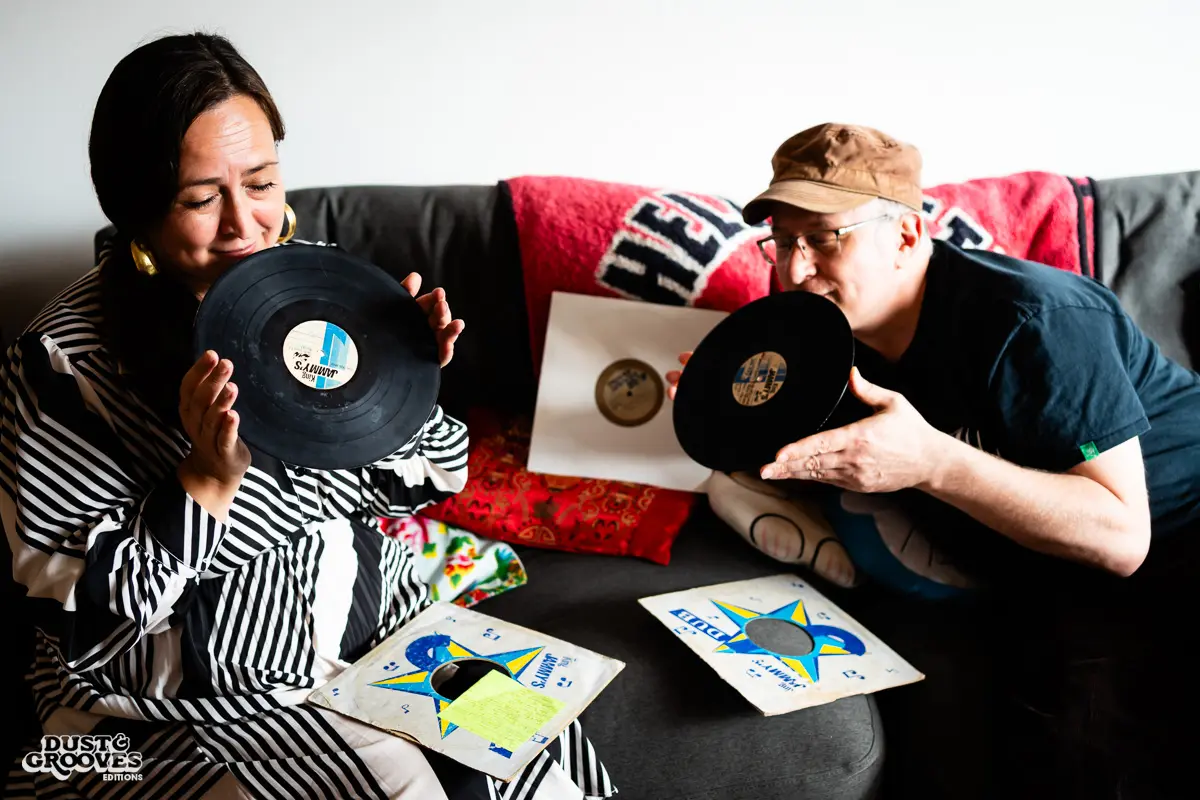
King Jammy’s “Eau de Dubplate.” DJ Food and Zoë caught sniffing Dubplates. “I haven’t had any dubplates cut for myself yet, but I’ve thought about it, and these ones are of particular interest to me for different reasons. You can only play dubplate acetates a certain amount of times and who knows how many spins these have already had? So yeah, these don’t get played very often.”
How do you go about finding records?
In my late twenties, I was introduced to “the list.” Andrew Neale is based in Nottingham and has produced a record sales list for 35 years. Once a month, you’d get a paper list in the post of records, and then you’d have to quickly phone Andrew to tell him which ones you wanted, and then pay for them.
What was on the list? Only reggae?
Mainly reggae but with some original sound system RnB stuff. Andrew would buy collections in Jamaica and the UK. Andrew’s still doing the list to this day, with email now, but he hasn’t changed; he still does it on his typewriter. He’ll do it on the typewriter, and then he’ll scan it in and email it. There’s no order to it, and when you do it on the typewriter, there’s no way you could search through.
On the cover and back page, he scans some of the records’ labels that will be on the list. He’s always making jokes in it, and it’s quite a fun thing to do, and you know there’s that feeling of, “Who’s gonna get there first…”
And does he still go to Jamaica to buy collections?
He hasn’t been for a while, but told me he still has parcels he hasn’t opened from Jamaica.
Andrew did a clash a few years ago, which I was part of. It was an old hits clash.
Can you explain what happens in a clash for the uninitiated?
Well, there are two types of clash. There’s a sound clash where two sound systems will clash against each other. It’s all about who sounds the best and the loudest and who has the most exclusive tracks.
Then the other clash is a DJ clash, where you’re just clashing as DJs on somebody’s sound, right? So I entered two of those. The first was a lovers rock and revival cup clash in Catford.
It was me and I had an MC, Mad X; my friend Lisa was with me, and we competed with that. Very strict rules. They sent us a list of about 100 tunes we weren’t allowed to play because they are popular. Lovers rock had to be UK lovers rock; somebody got thrown out for playing a Jamaican track. The records had to be an original press, someone got chucked out for playing a repress, and it had to be released before 1984, which was the cutoff. But there were different rounds; the first round was party anthems, then a roots round, and then a Studio One—Jamaica’s Motown label. I didn’t get through on that one, for several reasons…
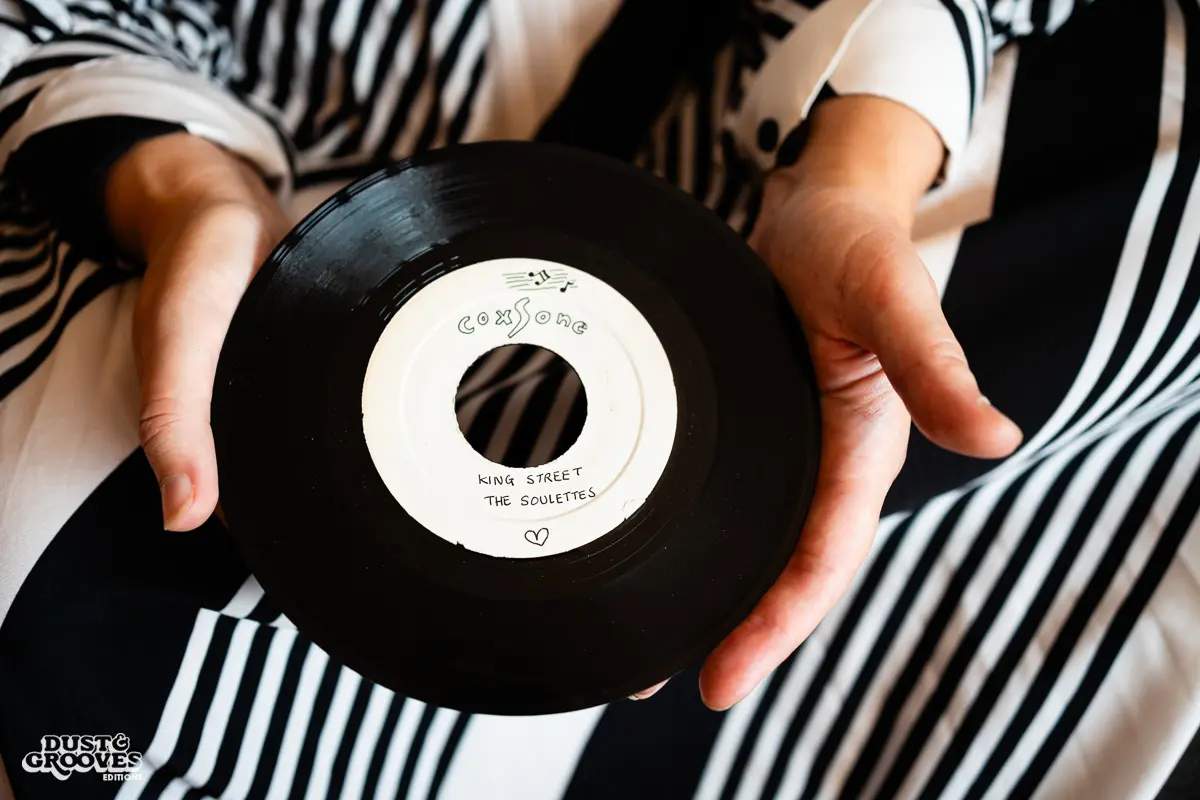
The Soulettes – “King Street.” The Soulettes were a vocal trio in ‘60s Jamaica headed up by Rita Marley. The Soulettes style of harmonising was influenced by American doo wop and RnB records that were popular in Jamaica in the ‘50s and ‘60s. “Here you can see I have drawn the Coxsone logo and written the title info onto the blank label. This is a bit of an oddity as one side of this record has a label (pictured below), but the other side is blank. This is a beautiful record with sweet vocals and a jaunty beat; I love it so.”
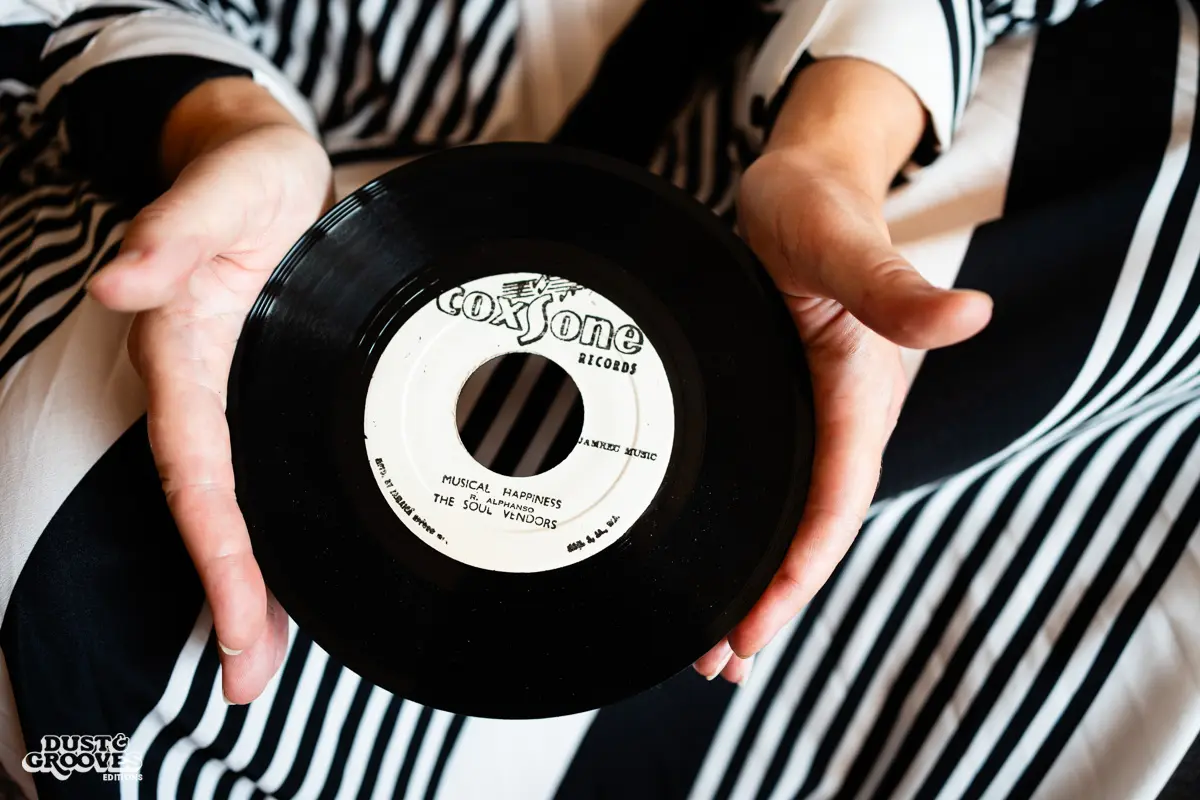
The Soul Vendors – “Musical Happiness.” The producer, Coxsone Dodd, assembled a backing group of musicians in 1967 to form The Soul Vendors: Roland Alphonso, Jackie Mittoo, Johnny Moore, Lloyd Brevett, Bunny Williams, and Errol Walters. The band would accompany many great, talented singers who recorded at Studio One in Jamaica. “I have been guilty of not turning over to hear the B side and missing some gems. Now I always flip the 45 to find out if there is a hidden treasure! In the ‘70s, it became custom to put an instrumental version on the B side so that MCs could toast over the rhythm after playing the vocal side. Before that, you might have a ballad on the flip or a great instrumental like this one.”
So, the crowd’s reaction determines what you play?
Well, it depends. In this one, they had judges scoring, and they also had crowd reaction for tie-break situations. I’m telling you, this place was packed. There were people there with these klaxon horns going, “Deeeeeeeeeeeeeerrrrr!!!” It was quite intimidating playing there, but I enjoyed it.
There was a point where I went through because I played a classic clash song called “Hard Man Fe Dead” by Prince Buster, and it’s got a line in it about the cat having nine lives. I made a little joke on the mic before I played it, and then everyone went absolutely nuts. It was great, and then the other guy played a (Prince) Buster instrumental called “Apache” as if he was gonna scalp me. It didn’t have any lyrics, and even though it was a 1000-pound tune and mine was 50 pounds, my tune won. I met him recently, and he said, “When it happens again, I will beat you.” So yeah, the competitive side is quite fun.
The other one I did—Andrew’s one in Nottingham—was different with no lovers rock, it was just called “Old Hits” and the cut-off was 1981. It had many different rules; you weren’t allowed to play any dubs or specials—a special is where they call the sound system’s name. So if I wanted to go and get one cut, I’d get someone saying, “Lucky Cat is the greatest, she’ll mash up any sound…” That’s the special, and then the dub is when you get the slightly different mix.
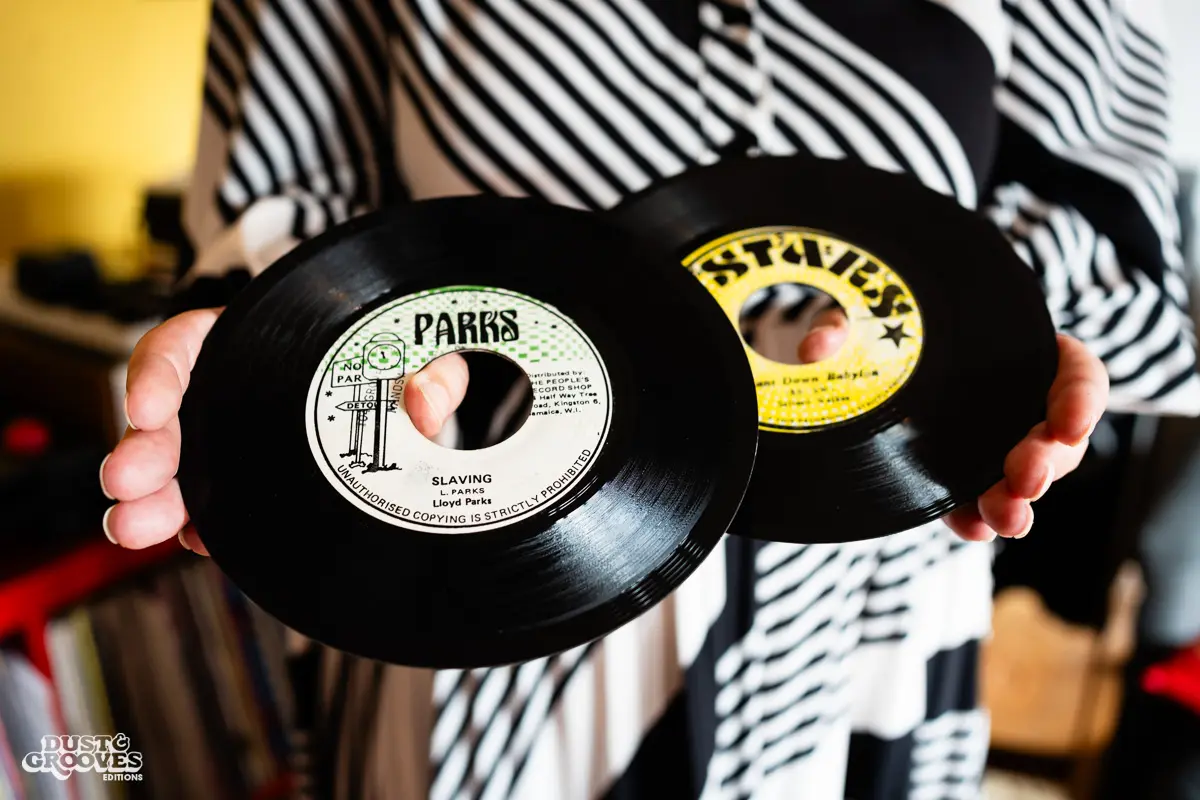
Lloyd Parks – “Slaving,” Selford Walker – “Chant Down Babylon.” Two classic roots tunes on the same rhythm, both produced by Tappa Zukie. Selford is misspelled on the label; spelling misnomers are commonplace in reggae. “I played these two back to back in the Tradition clash; they went down very well. Because each round was only 10 minutes long, I did not play the tunes right to the end. I wanted to pack in as many great old hits as possible.”
Dubs are traditionally 10-inch, right? They’re not 7-inch?
Yeah, this ties in nicely. This is a 10-inch on a blank.
What’s a blank? Like a white label?
For me, I love the Jamaican blank, the sound quality is always really good. Also, nobody knows what you’re playing! There’s something nice about the blank. As you can see, it’s got a stamp on it, and often in reggae, they will cut lots of different versions, and it’s all about which version you’ve got and who’s got the most versions.
This is an organ instrumental cut to the Stranger Cole classic, “Bangarang”, [sings] “Woman a wah, bangarang.” I played this in the clash because it has a great intro. So when you play in the clash, there’s one turntable, not two turntables, which is the vintage reggae style, so you’ve got somebody on the mic, and then you turn the records [plays record intro].
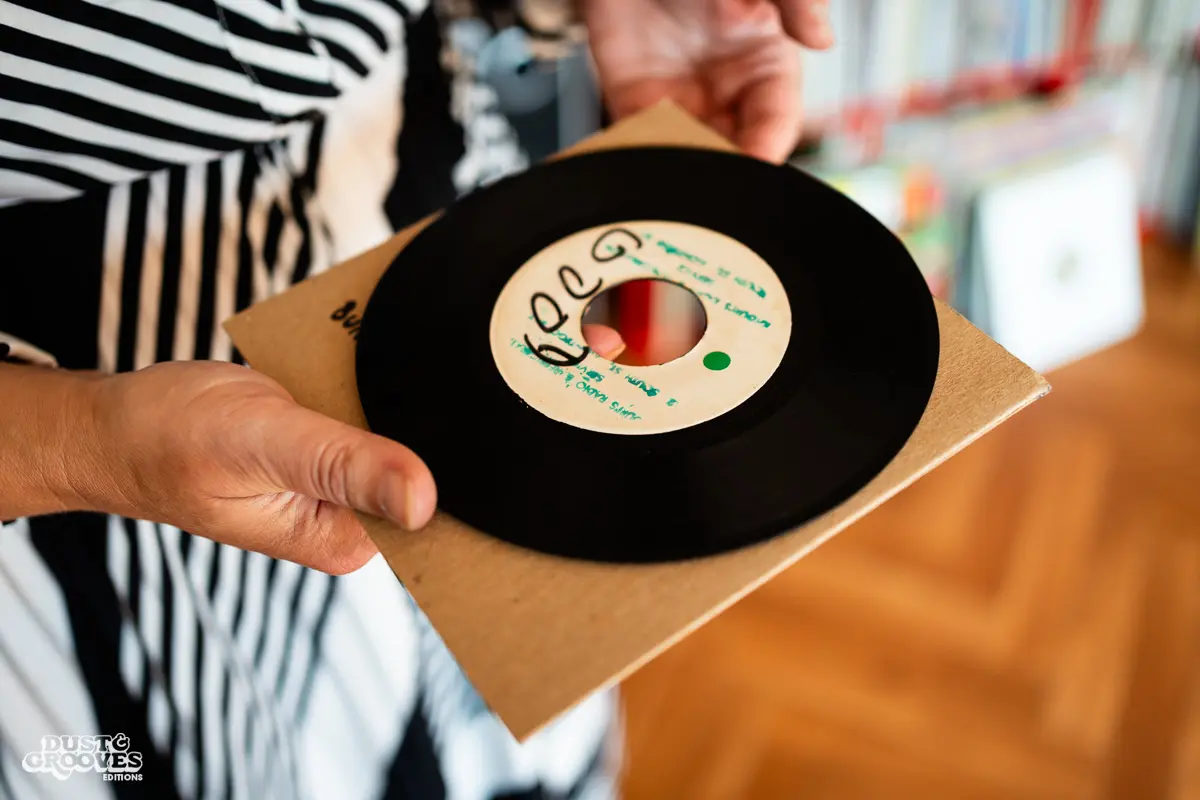
Aston “Family Man” Barrett with U Roy – “Orgarang.” This is an organ instrumental piece of the classic “Bangarang” by Lester Sterling and Stranger Cole. “I played this in the Tradition Cup Clash. This is a pre-release—Jamaican blank. If you are in a clash and can answer someone with a rarer tune than the one they just played, you are doing well! I added a small green dot sticker to remind me which side to put on. In the Tradition Clash, we used just one turntable, and no headphones, so putting the right side on was pretty important!”
“Lucky Cat Radio has a bit of everything, it's a magazine-style program, and I'd have interviews. It wasn't a predominantly reggae show; some people just wanted to hear the reggae, some people just wanted to hear about recipes.”
Getting back on track, you became a DJ for your sister’s birthday…
Yeah, and then I thought, “Oh, actually, I quite like this. I’m pretty good at it.” I started to buy more 7-inches, and then I started a night with a couple of friends called “Messy” in Camberwell.
When was this?
Around 2003, I started a few years before my daughter was born in 2006. “Messy” nights were with two guys I went to school with, Will and Navindh, who also DJ’d. We used to take our own equipment there; it was a bit of a schlep. We played in the backroom of the Joiners Arms and had some really funny nights. We did a Chinese New Year party there, where Will and I made like 200 spring rolls.
Wow, and that was all reggae?
It was all reggae, funk, soul—it was a bit of a mix-up, because they’d like to play more funk and soul stuff as well. So I was DJing with them, and a little on my own. Then I got involved in a campaign in Chinatown to save the pagoda, which was going on at the time, and some regeneration stuff.
Anyway, I decided to make a program for Resonance FM about the Chinatown campaign. Then they asked, “Would you like to do a show? Your own show, a regular one?” Instead of just some one-off programs. It was actually Ben Drew, an artist he recommended to me, so big-up to Ben. I asked, “How can I cram all my interests into one show?” I decided on Lucky Cat, which was a chop suey of East Asian and black music, really, American and Jamaican. I also explored my love for Chinese and East Asian culture, films, and food through the show.
Did you use that interest almost like a theme or an angle?
It has a bit of everything, it’s a magazine-style program, and I’d have interviews. It wasn’t a predominantly reggae show; some people just wanted to hear the reggae, some people just wanted to hear about recipes. I started doing that from 2006, before that it was just one-off stuff…
Another thing that influenced me to collect this (Asian) style of music was the films of Wong Kar Wai, who directed my favorite films, In The Mood For Love and Chungking Express. The Chungking Express soundtrack also features some Dennis Brown, reggae, Nat Cole, Connie Francis, Xavier Cugat, and all these Chinese chanteuses.
I grew up totally in love with the golden age of Hollywood and Technicolor, so when I discovered the world of Chinese cinema and its similarities, I really fell in love with it.
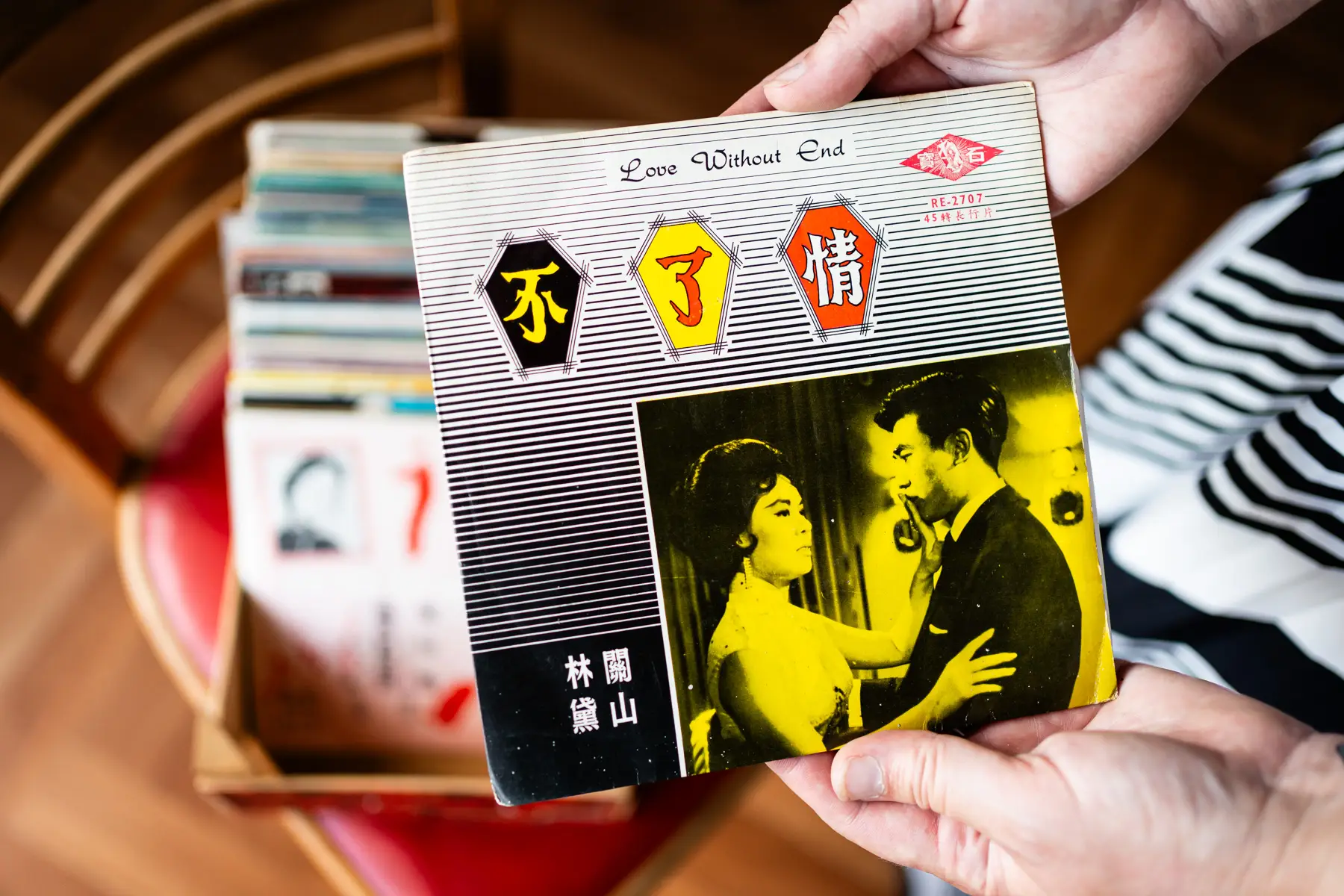
Carrie Koo Mei – “Love Without End.” What is known in Hong Kong as an evergreen song. “Love Without End” is from a film of the same name starring Linda Lin Dai. Linda sings it in the movie, but we hear Carrie Koo Mei’s vocals. “I just love this. This makes me cry (if a record makes me cry, I have to buy it, it’s part of my criteria). This is a beautiful love song, and it’s a classic. Every old Chinese lady will know this. Unfortunately, the actress Linda Lin Dai had a tragic end, which makes it all the more emotional. It’s a powerful ballad oozing in sentimentality, a real torch song. The sleeve design is beautiful to me too; the little lanterns and graphics are heavenly.”
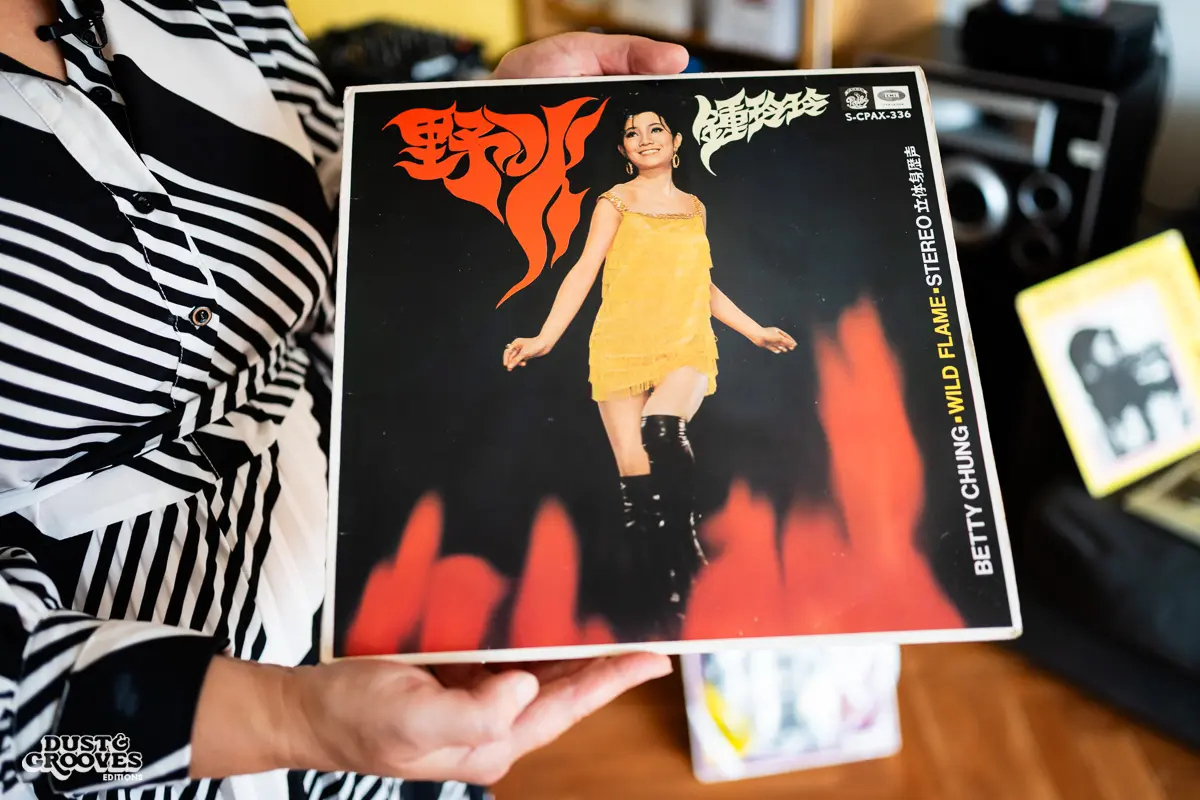
Betty Chung – Wild Flame. “Betty is a Chinese singer and actress most famous for starring alongside Bruce Lee in Enter The Dragon. This LP is fabulous, and EMI did some great typography with Chinese characters on the sleeve. The best track for me is a stunning cover of ‘Sunny.’ I would describe this as ‘Asia beat’— it has a funky yé-yé garage sound. Love it!”
“The cinema of Hong Kong never ceases to amaze me—such a prolific output of wonderful films, right up to the ’90s. Most of the stars also made music too. It was a real Hollywood-style star system, but with a Hong Kong twist.”
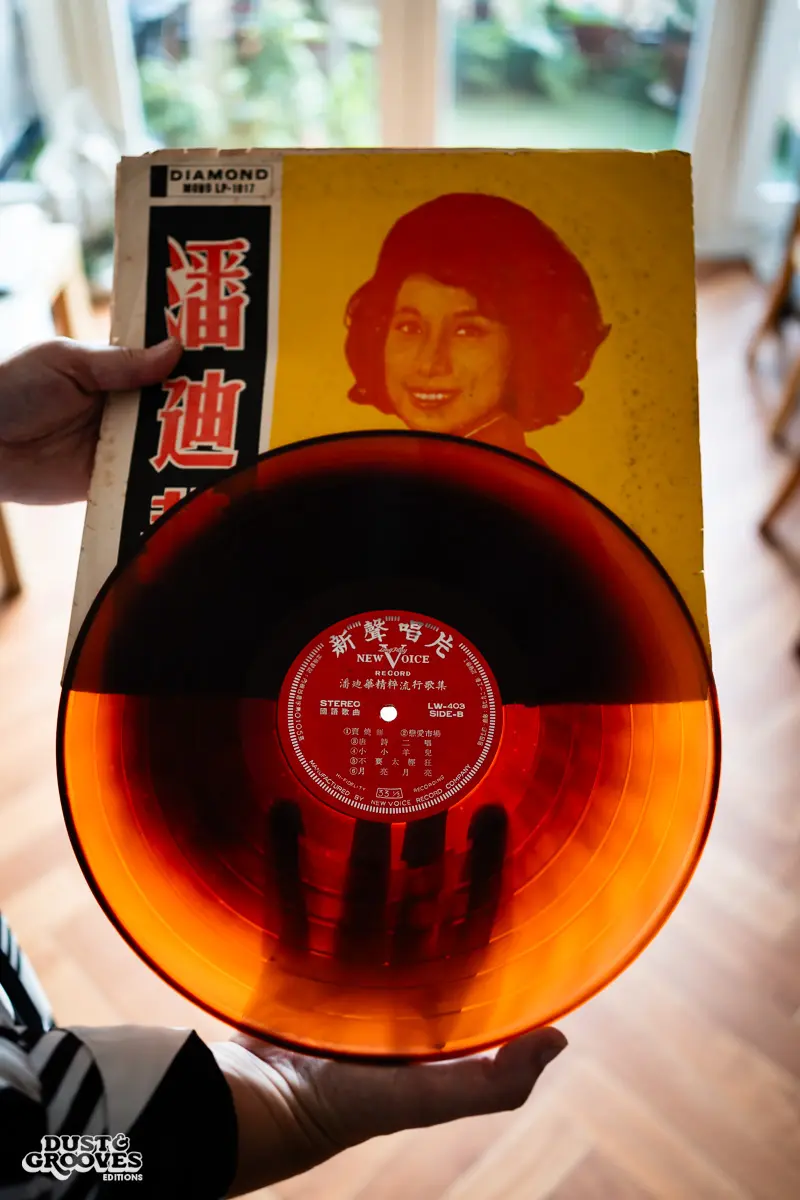
Rebecca Pan – Sings Pan Wan Ching. “Rebecca’s music was featured in the Wong Kar Wai film In The Mood For Love. It is so desperately romantic and sensuous! I love that film so much, especially its big ‘60s hair, gorgeous cheongsam dresses, and yearning, oh, the yearning! The nicest thing anyone has ever said about my show was that it sounded like, ‘If Wong Kar Wai had a radio show.’ This edition is a Taiwanese bootleg on transparent orange vinyl.”
How do reggae and Asian culture connect?
So, one of my specialist interests is the Chinese reggae pioneers and the influence of the Chinese on reggae music. Bob Marley cut his first record for a Chinese producer in Jamaica called Leslie Kong, who had Beverly’s record label. Unfortunately, Leslie Kong died in 1972 of a heart attack. However, other people from Canton and mainland China had also moved to Jamaica. There was a Chinatown in Kingston, for example. There was a considerable Chinese population in Jamaica. So there’s that big connection, like Justin Yap was a producer of The Skatellites. You’ve got Randy Chin, and his wife, Pat Chin—Miss Pat is still with us, and she manages VP Records, the largest reggae record label in the world.
She no longer lives in Jamaica; a lot of Chinese people moved to America and Canada because there were anti-Chinese riots in Jamaica in the 1970s as a result of the political turmoil of the time and economic difficulties.
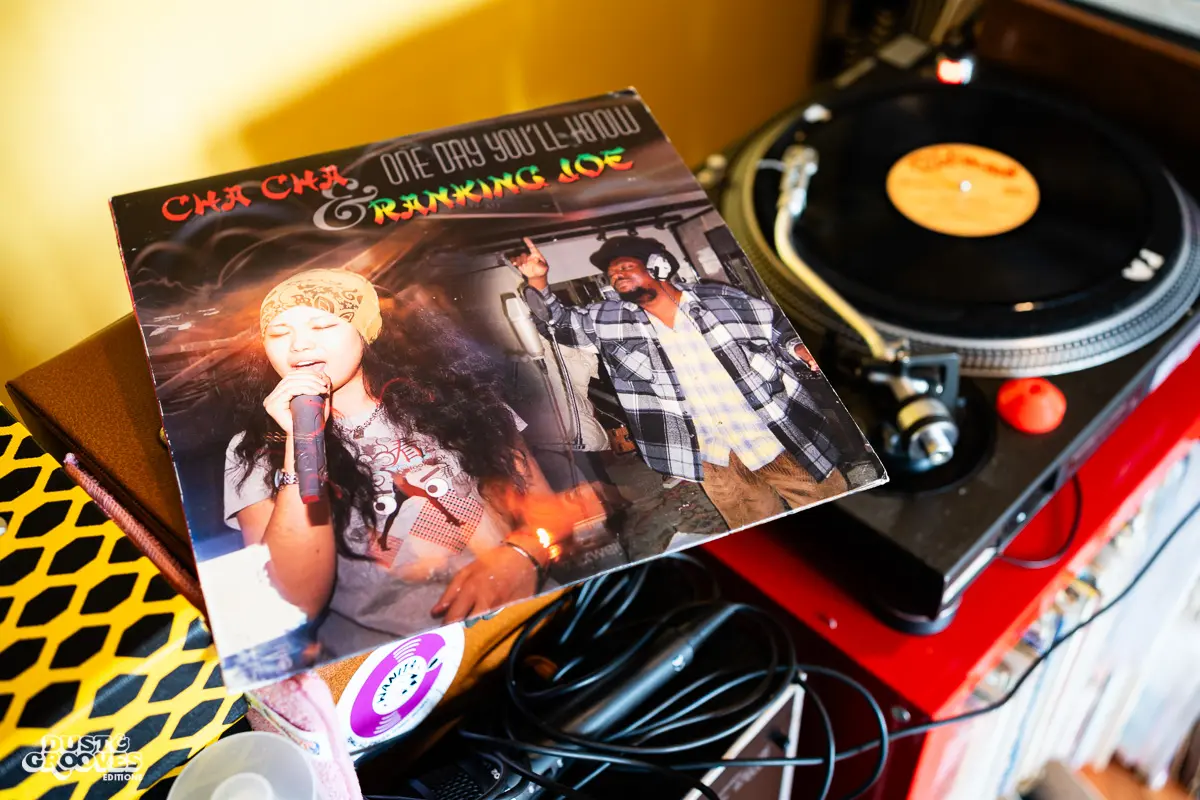
Cha Cha and Ranking Joe – One Day You’ll Know. “I became fascinated by the history of the Chinese diaspora in Jamaica and the influence of Chinese producers and musicians on reggae music pretty early on in my record-collecting journey. This 10-inch record is a beautiful culmination of past and present, which crosses continents and pays homage to the two countries’ history. Cha Cha sings in Mandarin with Ranking Joe chatting lyrics in his distinctive patois trill and features the great trombonist Rico Rodriguez. This record kind of brings everything together for me.”
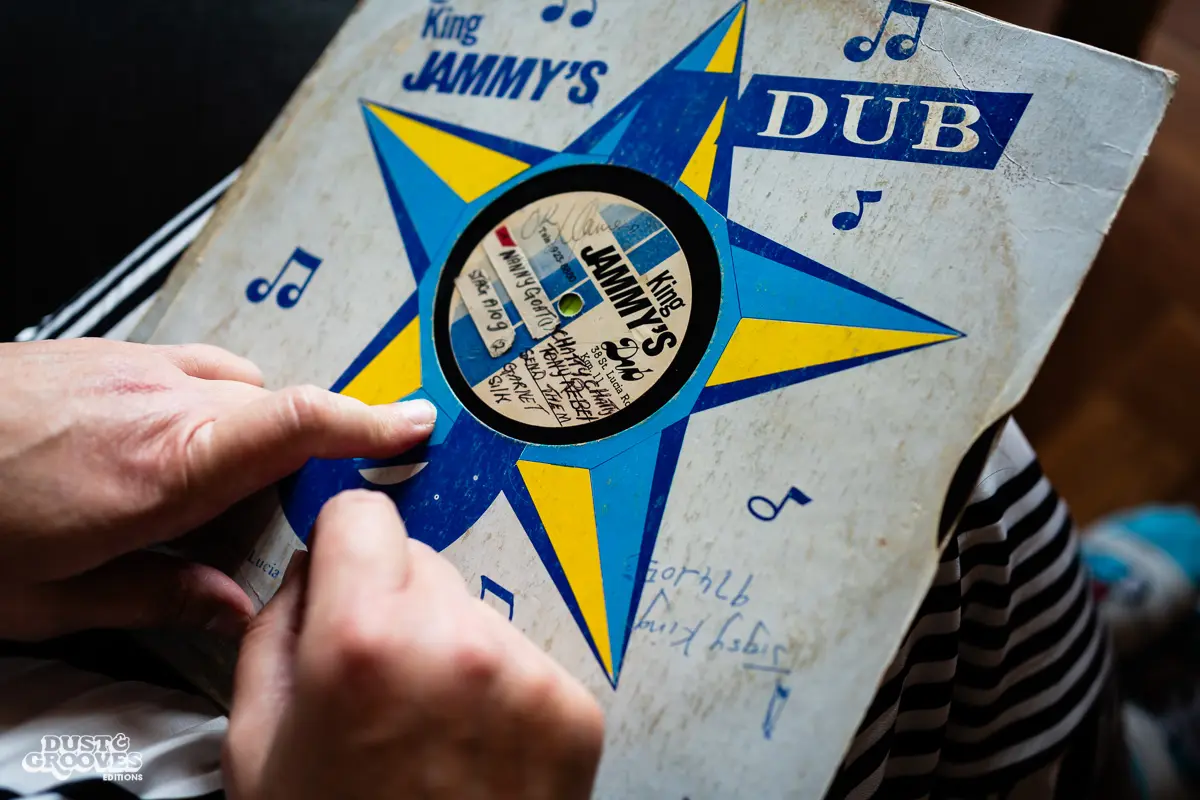
Garnett Silk – “Stalag.” Garnett Silk was an incredible singer heralded as possibly the new Bob Marley. During a gas explosion at his mother’s house, he went in to try and save her but died in the blaze. “This is just one of my favorite rhythms. I bought these from Andrew [Neale], and the two things that come together for me here are the Stalag rhythm and Garnett Silk. He’s got such a beautiful voice, and it is my favorite rhythm.”
So the Chinese had to go to Jamaica to infuse reggae. Reggae didn’t come to China?
There’s a bit of a reggae scene in China. There’s a reggae bar in Chengdu, and I heard some great reggae made in China. There’s a guy called Jiang Lang, whom I follow, who does lots of dubby stuff. It’s more like dub reggae and seems to go well in China and Hong Kong. There’s definitely a little reggae scene there.
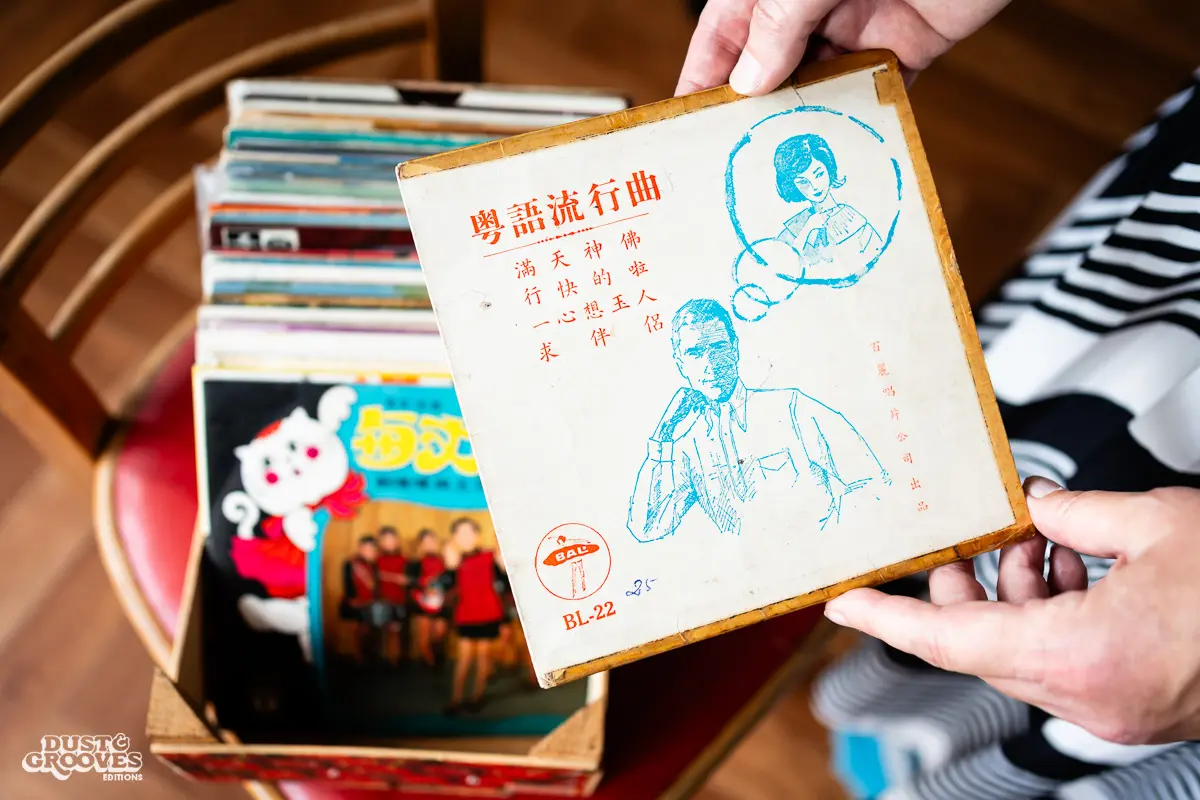
Gu Ye Lu – cover of “She Loves You” by The Beatles. “This is a flexi disc I bought in Hong Kong. I went to this guy called Paul Au’s record shop, and I would never have found it on my own. Luckily, these nice academics I’d met online talking about Chinese records took me to Paul’s store. It was in a big tower block, nothing on the door. It was on the 23rd floor or something, and I went in there. It was an absolute treasure trove; it was brilliant. This is one of the records that Paul himself recommended to me.”
Do they toast in Jamaican or in their native language?
In Mandarin. It’s not like Japan, yet, reggae’s massive in Japan. I haven’t been to Japan, but I understand and have heard that reggae is big. Some people in Japan, Rocka Shacka Dub Store, and Far East Records, for example, reissue original Jamaican 45s. I’m unsure how many people have record players in China, so it’s more like roots reggae in the mountains. That’s the impression that I get from China.
Have you been to record shops in China?
I’ve been to China and didn’t find any of them. When the Cultural Revolution happened, you would have found jazz 78s and things from Shanghai. But a lot of that just got trashed in the Revolution. When people leave, they don’t want to take records with them. They’re quite heavy, not really necessary.
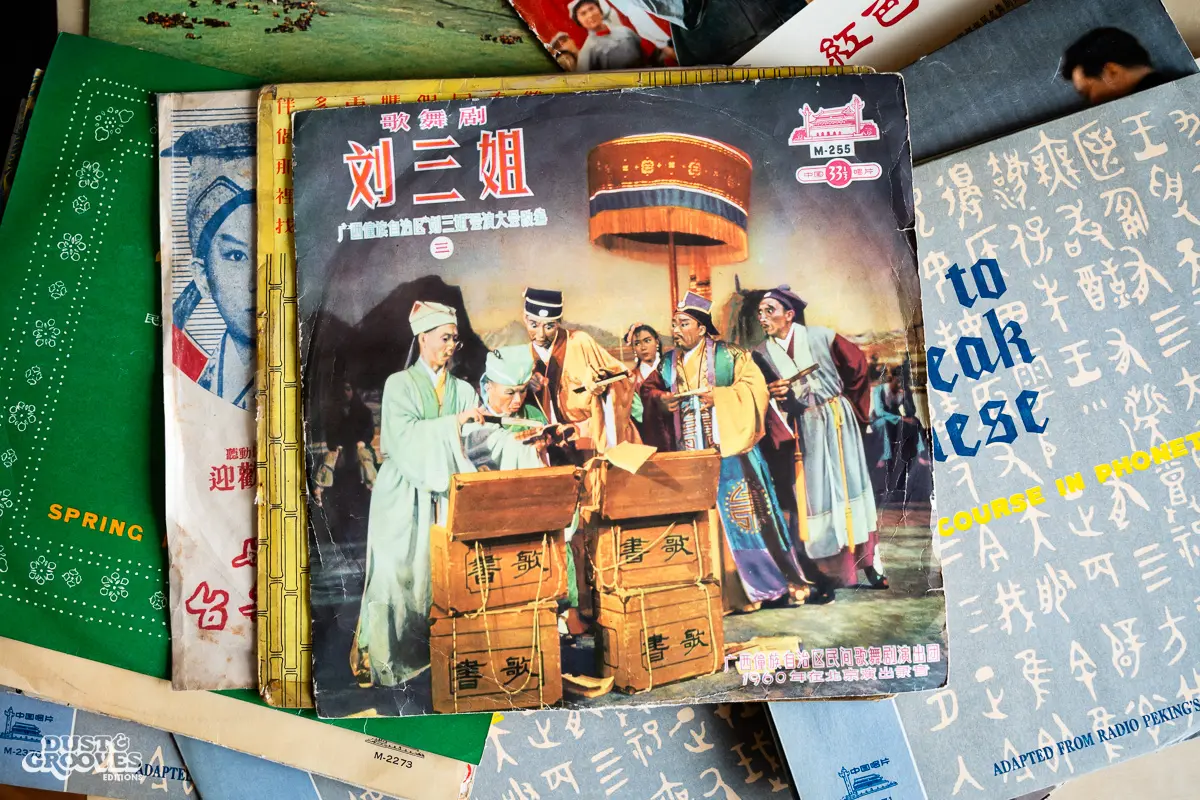
Various Chinese 10-inch LPs. The one at the forefront is a Huangmei opera “Liu San Jie” (translates roughly as “Third Daughter of the Liu Family”). The Chinese Record Corporation is a state-run record company started by the Chinese Communist Party when they came into power. “I started collecting CRC 10-inches some years ago. Whilst in Berlin, I was thrilled to find a record shop with a 10-inch section, which I made a beeline for. Sure enough, I found some lovely records. China Record Company records mainly released records on 10-inch. In the background, you can see an educational record teaching you how to speak Mandarin. I used some samples from this on jingles for my Resonance FM radio show.“
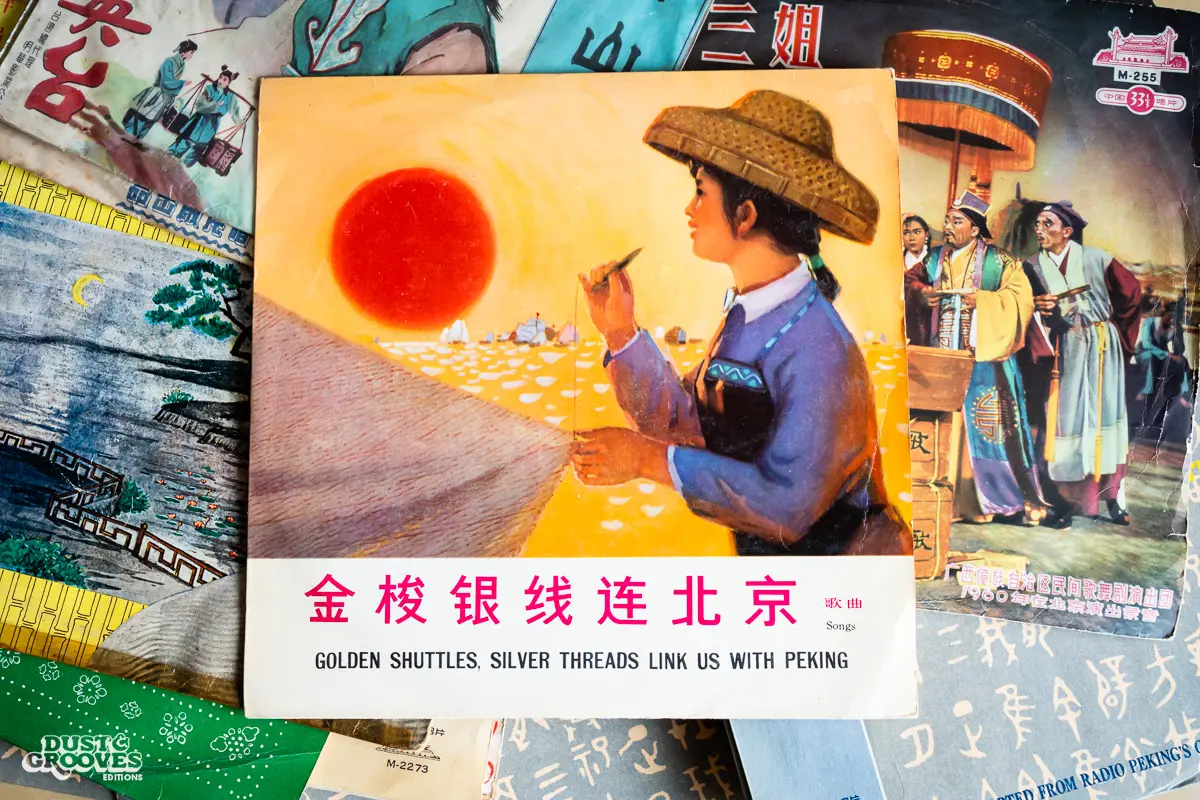
Various – Golden Shuttles, Silver Threads Link Us With Peking – Songs. “I picked this up in Berlin, most of these were from Berlin because of the East Germany communist connection. I’m a big fan of communist posters, especially in the ‘50s and ‘60s, and I love that kind of revolutionary artwork and propaganda. I don’t play them that much because the sound is an acquired taste–there’s no bass. The ones that I like musically are the ones with a folk music style to them. Traditional Chinese instruments like the pipa originated in Iran as the oud, and then made it to China via the Silk Road.”
We’re back to the 7-inches now. What have you got there?
Some Chinese and Singaporean records. These are The Stylers from Singapore—they were a big group in the 1960s, and I put this on YouTube. One of them actually commented, saying, “Oh great to see our music still being played.”
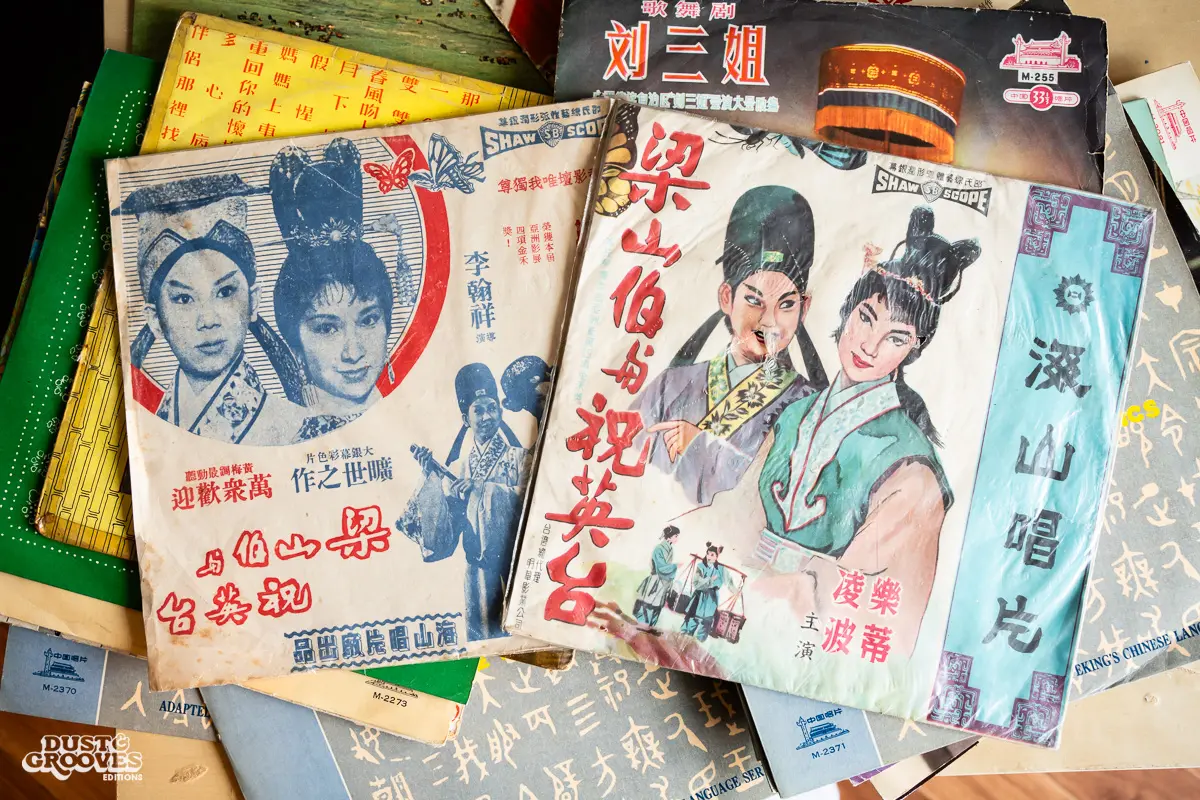
Tsin Ting, Long Po – The Love Eterne. The Love Eterne is based on a classic of Chinese literature, The Butterfly Lovers. “These are coloured vinyl, Taiwanese bootlegs I picked up on eBay. I used to go on Malaysian and Hong Kong eBay and kind of just guess things and buy blind, but I knew this film straight away. These are two wonderful actresses, Betty Loh Ti and Ivy Ling Po. It’s a Technicolor feast for the eyes and is filled with yearning and pain. The cinema of Hong Kong never ceases to amaze me, such a prolific output of wonderful films right up to the ‘90s. Most of the stars also made music; it was a real Hollywood-style star system with a Hong Kong twist.”
I’m not seeing many company sleeves; they all seem to be picture or photo sleeves. Was that the standard thing?
Picture sleeves were a big thing. But also bear in mind that I’ve looked for picture sleeves. So yeah, I have got some other ones that are not. There’s a record label called Diamond Records in Hong Kong. They didn’t have many sleeves. They have a Grace Chang 45 called “Oh Calypso.” Grace Chang is a very collectible singer; her records cost a lot.
The story with that one is that it was late one night, I was on eBay and I just sometimes decide to buy things randomly and that’s when I discovered it was actually a song that I’ve been looking for called “Oh Calypso” which is like a Chinese Calypso, so, very pleased with that.
Are you buying these (Chinese and Korean records) more for the visual aesthetic than the music that’s on them?
Yeah, I’m buying these with the visual aesthetic in mind. I love Chinese ideograms. I did learn Mandarin for a little while. I do know some basic characters, numbers, and things. I think it went like this: the Chinese food, the Chinese cinema, and finally the Chinese music.
Can you tell us a bit about the history of your radio show?
I started Lucky Cat in 2005 after I made a couple of one-off programs for resonance on a campaign to save the London Chinatown pagoda. Since then, I have made multiple series of Lucky Cat on Resonance. I moved out of London for a bit and then started getting back into it. So in 2016, I founded a female reggae collective called Sisters of Reggae, and we supported Sister Nancy in Brixton.
I did a little feature about reggae sound systems for one show, and I thought, “I’m going to do a whole series on this.” I’ve done four series of Sound System Stories on Resonance, an oral history of UK reggae sound systems, with interviews with many sound system operators, selectors, and MCs (deejays or toasters).
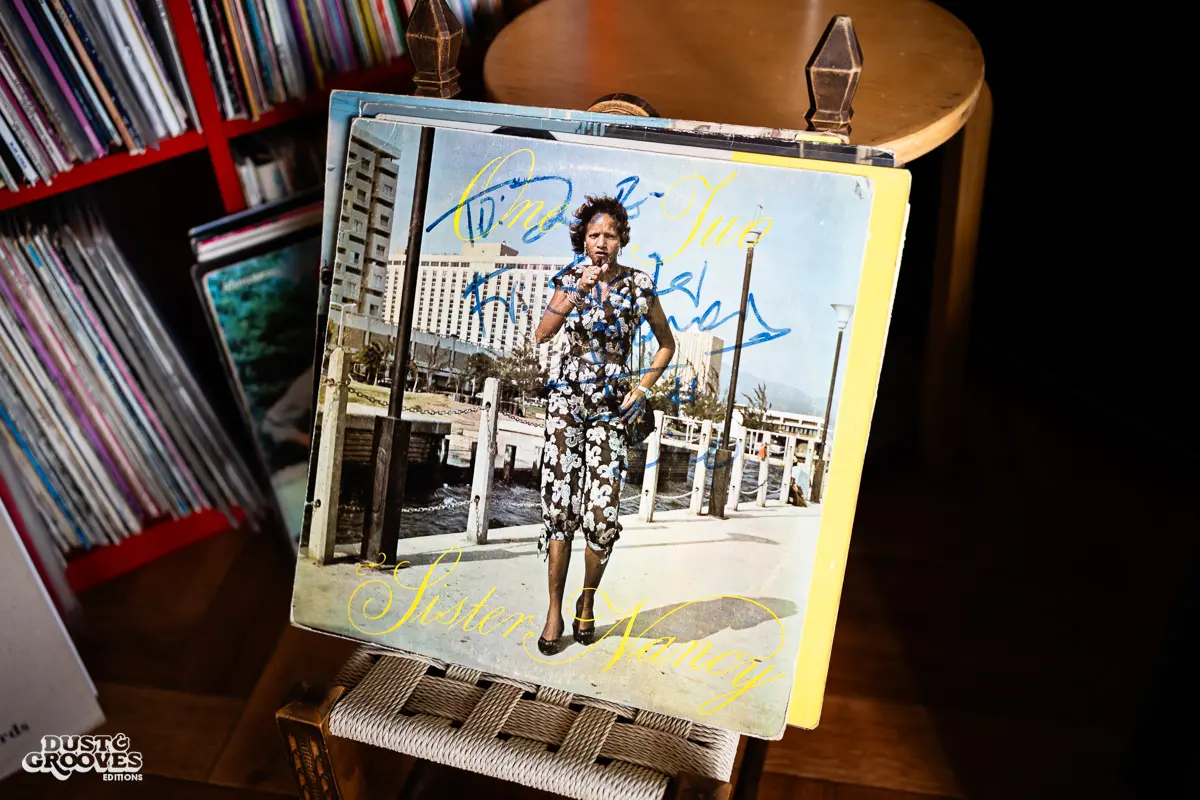
Sister Nancy – One, Two. Sister Nancy (Ophlin Russell) is known as the first prominent female DJ of Reggae dancehall. In 1996, Nancy left Jamaica for a different life, working as an accountant in a bank in New Jersey and leaving music behind. Sadly, this is a common trajectory for Jamaican female artists. Sister Nancy returned to the music business in 2016 after winning a legal battle to get the rights to her song ‘Bam Bam.’ This meant Nancy could retire from her accountant job and, luckily for all her fans, return to the stage. Nancy continues to tour the world today. “In 2016, Sisters of Reggae supported Sister Nancy in Brixton. We got to meet her backstage, and she signed this LP. She was so lovely and humble, I was so much in awe of her.”
And what does the future hold aside from your radio work?
I disbanded Sisters of Reggae in 2021 and have since enjoyed solo work and collaborating with different DJs and crews. I currently have a quarterly residency at the audiophile bar Spiritland with fellow DJ Jawa Jones, “East Asia Beat.” We are both passionate about East Asian music and promoting and working with other women. Last year, we were so proud to have DJ Honey from the Philippines as our special guest, another phenomenal woman DJ.
I’m a regular DJ at the fantastic Classic Car Boot Sale event in London and enjoy guest spots at various Reggae events in the UK and Europe. I particularly enjoy playing in Italy as the crowds are so excited and passionate about the music. A couple of my friends have valve sound systems; they are the best to play on. I love being invited to select lovely, crackly old rhythm and blues and ska records on these beautiful, warm-sounding sets.
My artwork is becoming more important to me and taking up more of my time; interweaving my passions for music and art is very exciting.
Who would you like to see featured next on Dust & Grooves?
My friend Tiny T The Mighty Cloudburst (Tennyson Goulbourne) in London has an incredible collection, so I’d love to see him featured. I admire the US-based collector Nina Cole; she is a big Hello Kitty fan and so stylish. I would love to see her amazing records. Paul Au, who is from Hong Kong, would be a winner. He is originally from Vietnam, has a massive personal collection of Vietnamese vinyl, and is a record seller.
Phyllis Dillon – “Perfidia” “Phyllis is the queen of rocksteady and didn’t have a long career because she got pissed off after being fucked over by producers in Jamaica. She ended up working in a bank in America. This is a Duke Reid production with a bit of talking on the track, which I love, and apparently, it’s Boris Gardiner. It’s a beautiful song.”
Further Adventures in Record Collecting
Dust & Grooves Vol. 2
Zoë and 150 other great collectors are featured in the book Dust & Grooves Vol 2: Further Adventures in Record Collecting.
Become a member or make a donation
Support Dust & Grooves
Dear Dust & Groovers,
For over a decade, we’ve been dedicated to bringing you the stories, collections, and passion of vinyl record collectors from around the world. We’ve built a community that celebrates the art of record collecting and the love of music. We rely on the support of our readers and fellow music lovers like YOU!
If you enjoy our content and believe in our mission, please consider becoming a paid member or make a one time donation. Your support helps us continue to share these stories and preserve the culture we all cherish.
Thank you for being part of this incredible journey.
Groove on,
Eilon Paz and the Dust & Grooves team


